Pioneer VSX-1021-K User Manual

AUDIO/VIDEO MULTI-CHANNEL RECEIVER RECEPTOR AUDIO-VIDEO MULTICANAL
VSX-1021-K
Register your product on
http://www.pioneerelectronics.com (US) http://www.pioneerelectronics.ca (Canada)
· Protect your new investment
The details of your purchase will be on file for reference in the event of an insurance claim such as loss or theft.
·Receive free tips, updates and service bulletins on your new product
·Improve product development
Your input helps us continue to design products that meet your needs.
· Receive a free Pioneer newsletter
Registered customers can opt in to receive a monthly newsletter.
Operating Instructions Manual de instrucciones

IMPORTANT NOTICE
THE MODEL NUMBER AND SERIAL NUMBER OF THIS EQUIPMENT ARE ON THE REAR OR BOTTOM. RECORD THESE NUMBERS ON YOUR ENCLOSED WARRANTY CARD AND KEEP IN A SAFE PLACE FOR FUTURE REFERENCE.
D36-AP9-1_A1_En
CAUTION
This product satisfies FCC regulations when shielded cables and connectors are used to connect the unit to other equipment. To prevent electromagnetic interference with electric appliances such as radios and televisions, use shielded cables and connectors for connections.
D8-10-3a_A1_En
This product is for general household purposes. Any failure due to use for other than household purposes (such as long-term use for business purposes in a restaurant or use in a car or ship) and which requires repair will be charged for even during the warranty period.
K041_A1_En
This Class B digital apparatus complies with Canadian ICES-003.
D8-10-1-3_A1_En
CAUTION:
HOT SURFACE. DO NOT TOUCH.
The top surface over the internal heatsink may become hot when operating this product continuously.
The Safety of Your Ears is in Your Hands
Get the most out of your equipment by playing it at a safe level – a level that lets the sound come through clearly without annoying blaring or distortion and, most importantly, without affecting your sensitive hearing. Sound can be deceiving. Over time, your hearing “comfort level” adapts to higher volumes of sound, so what sounds “normal” can actually be loud and harmful to your hearing. Guard against this by setting your equipment at a safe level BEFORE your hearing adapts.
ESTABLISH A SAFE LEVEL:
•Set your volume control at a low setting.
•Slowly increase the sound until you can hear it comfortably and clearly, without distortion.
•Once you have established a comfortable sound level, set the dial and leave it there.
BE SURE TO OBSERVE THE FOLLOWING GUIDELINES:
•Do not turn up the volume so high that you can’t hear what’s around you.
•Use caution or temporarily discontinue use in potentially hazardous situations.
•Do not use headphones while operating a motorized vehicle; the use of headphones may create a traffic hazard and is illegal in many areas.
S001a_A1_En
En 3

Thank you for buying this Pioneer product. Please read through these operating instructions so you will know how to operate your model properly. After you have finished reading the instructions, put them away in a safe place for future reference.
Contents
01 Before you start |
|
Checking what’s in the box............................ |
6 |
Installing the receiver...................................... |
6 |
Loading the batteries...................................... |
6 |
Operating range of remote control unit........ |
6 |
Canceling the demo display........................... |
6 |
About operation of the receiver with a |
|
mobile terminal (iPod, iPhone, etc.).............. |
6 |
About using AVNavigator (included |
|
CD-ROM).......................................................... |
6 |
02 Controls and displays |
|
Remote control................................................ |
8 |
Display.............................................................. |
9 |
Front panel..................................................... |
10 |
03 Connecting your equipment |
|
Connecting your equipment........................ |
11 |
Rear panel...................................................... |
11 |
Determining the speakers’ application....... |
11 |
Placing the speakers..................................... |
12 |
Connecting the speakers.............................. |
13 |
Installing your speaker system.................... |
13 |
Selecting the Speaker system...................... |
14 |
About the audio connection......................... |
15 |
About the video converter............................ |
15 |
About HDMI................................................... |
15 |
Connecting your TV and playback |
|
components................................................... |
16 |
Connecting an HDD/DVD recorder, BD |
|
recorder and other video sources................ |
18 |
Connecting a satellite/cable receiver or |
|
other set-top box............................................ |
18 |
Connecting other audio components......... |
19 |
Connecting AM/FM antennas...................... |
19 |
MULTI-ZONE setup....................................... |
20 |
Connecting a SiriusConnect Tuner............. |
20 |
Connecting to the network through |
|
LAN interface................................................. |
20 |
Connecting optional Bluetooth |
|
ADAPTER....................................................... |
21 |
Connecting an iPod...................................... |
21 |
Connecting a USB device............................. |
21 |
Connecting to the front panel video |
|
terminal.......................................................... |
21 |
Connecting to a wireless LAN...................... |
22 |
Connecting an IR receiver............................ |
22 |
Operating other Pioneer components |
|
with this unit’s sensor................................... |
22 |
Plugging in the receiver................................ |
23 |
04 Basic Setup |
|
Changing the OSD display language |
|
(OSD Language)............................................ |
24 |
Automatically conducting optimum |
|
sound tuning (Full Auto MCACC)................ |
24 |
The Input Setup menu.................................. |
25 |
Operation Mode Setup................................. |
26 |
05 Basic playback |
|
Playing a source............................................ |
28 |
Playing an iPod.............................................. |
28 |
Playing a USB device.................................... |
29 |
Listening to the radio.................................... |
31 |
Listening to Satellite Radio........................... |
31 |
Bluetooth ADAPTER for Wireless |
|
Enjoyment of Music...................................... |
33 |
06 Listening to your system |
|
Auto playback................................................ |
35 |
Listening in surround sound........................ |
35 |
Using Stream Direct..................................... |
36 |
Selecting MCACC presets............................ |
36 |
Choosing the input signal............................ |
36 |
Better sound using Phase Control.............. |
37 |
07 Playback with HOME MEDIA |
|
GALLERY inputs |
|
Enjoying the Home Media Gallery............... |
38 |
Features of Home Media Gallery................. |
38 |
Introduction................................................... |
38 |
Playback with Home Media Gallery............. |
38 |
Advanced operations for Internet radio...... |
40 |
About network playback............................... |
40 |
About playable file formats........................... |
41 |
08 Control with HDMI function |
|
About the Control with HDMI function....... |
43 |
Making Control with HDMI connections.... |
43 |
HDMI Setup................................................... |
43 |
Before using synchronization...................... |
44 |
About synchronized operations................... |
44 |
Setting the PQLS function ........................... |
44 |
Cautions on the Control with HDMI |
|
function.......................................................... |
45 |
09 Using other functions |
|
Setting the Audio options............................. |
46 |
Setting the Video options............................. |
48 |
Switching the speaker terminals................. |
49 |
Using the MULTI-ZONE controls................. |
49 |
Making an audio or a video recording......... |
50 |
Reducing the level of an analog signal....... |
50 |
Using the sleep timer.................................... |
50 |
Dimming the display..................................... |
50 |
Checking your system settings.................... |
50 |
Resetting the system.................................... |
50 |
10 Controlling the rest of your system |
|
About the Remote Setup menu................... |
52 |
Operating multiple receivers........................ |
52 |
Setting the remote to control other |
|
components................................................... |
52 |
Selecting preset codes directly.................... |
52 |
Programming signals from other |
|
remote controls............................................. |
53 |
Erasing one of the remote control |
|
button settings.............................................. |
53 |
Erasing all learnt settings that are in |
|
one input function......................................... |
53 |
Direct function............................................... |
54 |
Multi Operation and System Off.................. |
54 |
Resetting the remote control settings......... |
55 |
Controlling components............................... |
56 |
11 The Advanced MCACC menu |
|
Making receiver settings from the |
|
Advanced MCACC menu.............................. |
58 |
Automatic MCACC (Expert)......................... |
58 |
Manual MCACC setup.................................. |
60 |
Checking MCACC Data................................ |
62 |
Data Management........................................ |
63 |
12 The System Setup and Other |
|
Setup menus |
|
Making receiver settings from the |
|
System Setup menu...................................... |
64 |
Manual speaker setup.................................. |
64 |
Network Setup menu.................................... |
66 |
Checking the Network Information............. |
67 |
The Other Setup menu.................................. |
68 |
13 Additional information |
|
Troubleshooting 1......................................... |
70 |
Troubleshooting 2......................................... |
76 |
About status messages................................ |
80 |
Important information regarding the |
|
HDMI connection.......................................... |
80 |
Cleaning the unit........................................... |
80 |
Surround sound formats.............................. |
81 |
About iPod..................................................... |
81 |
About SIRIUS................................................. |
81 |
About FLAC.................................................... |
81 |
Auto Surround, ALC and Stream Direct |
|
with different input signal formats.............. |
82 |
Glossary.......................................................... |
83 |
Features index............................................... |
85 |
Specifications................................................ |
86 |
Preset code list.............................................. |
86 |
4 En

Flow of settings on the receiver
Flow for connecting and setting the receiver
The unit is a full-fledged AV receiver equipped with an abundance of functions and terminals. It can be used easily after following the procedure below to make the connections and settings.
Required setting item: 1, 2, 3, 4, 5, 7, 9
Setting to be made as necessary: 6, 8, 10, 11, 12
 Important
Important
The receiver’s initial settings can be made on the computer using Wiring Navi on the AVNavigator CD-ROM included with the receiver. In this case, virtually the same connections and settings as
in steps 2, 3, 4, 5, 6, 7 and 8 can be made interactively. For instructions on using AVNavigator, see
About using AVNavigator (included CD-ROM) on page 6 .
1Before you start
!Checking what’s in the box on page 6
!Loading the batteries on page 6
j
2Determining the speakers’ application (page 11)
!7.1 channel surround system (Front height)
!7.1 channel surround system (Front wide)
!7.1 channel surround system & Speaker B connection
!5.1 channel surround system & Front Bi-amping connection (High quality surround)
!5.1 channel surround system & ZONE 2 connection (Multi Zone)
j
3Connecting the speakers
!Placing the speakers on page 12
!Connecting the speakers on page 13
!Installing your speaker system on page 13
!Bi-amping your speakers on page 14
j
4Connecting the components
!About the audio connection on page 15
!About the video converter on page 15
!Connecting your TV and playback components on page 16
!Connecting AM/FM antennas on page 19
!Plugging in the receiver on page 23
j
5 Power On
j
6 Changing the OSD display language (OSD Language) (page 24) j
7MCACC speaker settings
!Automatically conducting optimum sound tuning (Full Auto MCACC) on page 24 j
8The Input Setup menu (page 25)
(When using connections other than the recommended connections) j
9Basic playback (page 28) j
10Adjusting the sound and picture quality as desired
!Using the various listening modes (page 35)
!Better sound using Phase Control (page 37)
!Measuring the all EQ type (SYMMETRY/ALL CH ADJ/FRONT ALIGN) (page 58)
!Changing the channel level while listening (page 65)
!Switching on/off the Acoustic Calibration EQ, Auto Sound Retriever or Dialog Enhancement (page 46)
!Setting the PQLS function (page 44)
!Setting the Audio options (page 46)
!Setting the Video options (page 48)
j
11Other optional adjustments and settings
! Control with HDMI function (page 43) ! The Advanced MCACC menu (page 58)
! The System Setup and Other Setup menus (page 64) j
12Making maximum use of the remote control
! Operating multiple receivers (page 52)
! Setting the remote to control other components (page 52)
En 5
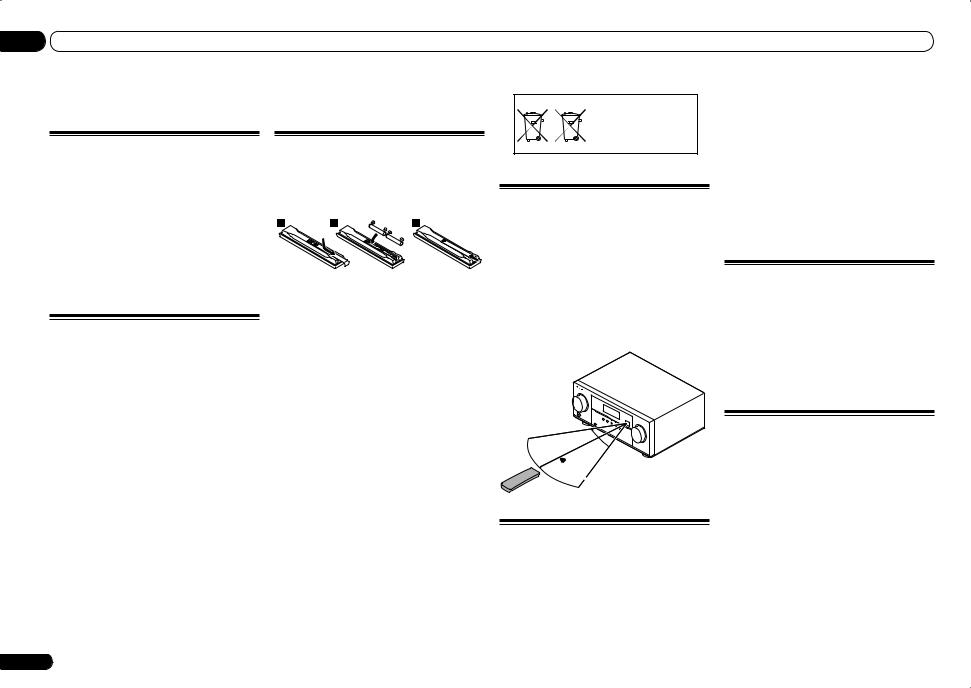
01 Before you start
Before you start
Checking what’s in the box
Please check that you’ve received the following supplied accessories:
!Setup microphone (cable: 5 m (16.4 ft.))
!Remote control unit
!AAA size IEC R03 dry cell batteries (to confirm system operation) x2
!AM loop antenna
!FM wire antenna
!iPod cable
!CD-ROM (AVNavigator)
!These operating instructions
Installing the receiver
!When installing this unit, make sure to put it on a level and stable surface.
!Don’t install it on the following places:
—on a color TV (the screen may distort)
—near a cassette deck (or close to a device that gives off a magnetic field). This may interfere with the sound.
—in direct sunlight
—in damp or wet areas
—in extremely hot or cold areas
—in places where there is vibration or other movement
—in places that are very dusty
—in places that have hot fumes or oils (such as a kitchen)
!Do not touch this receiver’s bottom panel while the power is on or just after it is turned off. The bottom panel becomes hot when the power is on (or right after it is turned off) and could cause burns.
Loading the batteries
The batteries included with the unit are to check initial operations; they may not last over a long period. We recommend using alkaline batteries that have a longer life.
 WARNING
WARNING
!Do not use or store batteries in direct sunlight or other excessively hot place, such as inside a car or near a heater. This can cause batteries to leak, overheat, explode or catch fire. It
can also reduce the life or performance of batteries.
 CAUTION
CAUTION
Incorrect use of batteries may result in such hazards as leakage and bursting. Observe the following precautions:
!Never use new and old batteries together.
!Insert the plus and minus sides of the batteries properly according to the marks in the battery case.
!Batteries with the same shape may have different voltages. Do not use different batteries together.
!When disposing of used batteries, please comply with governmental regulations or environmental public instruction’s rules that apply in your country or area.
(Symbol examples for batteries)
These symbols are only valid in the European Union.
Pb |
K058c_A1_En |
Operating range of remote control unit
The remote control may not work properly if:
!There are obstacles between the remote control and the receiver’s remote sensor.
!Direct sunlight or fluorescent light is shining onto the remote sensor.
!The receiver is located near a device that is emitting infrared rays.
!The receiver is operated simultaneously with another infrared remote control unit.
30° 
 30°
30° 
 7 m (23 ft.)
7 m (23 ft.)
Canceling the demo display
On this receiver, the demo mode is turned on by default. When the power is turned on, the demo display is set and various indications are shown on the front panel display. To cancel the demo display, connect the power cord, then perform the operation below.
!The demo mode is canceled automatically when the Full Auto MCACC operation is performed.
1Switch the receiver into standby.
2While holding down ENTER on the front panel, press uSTANDBY/ON.
The display shows RESET c NO d.
3Select ‘FL DEMO’ using TUNE i/j.
4Use PRESET k/l to select FL DEMO c OFF dthen press ENTER on the front panel.
About operation of the receiver with a mobile terminal (iPod, iPhone, etc.)
The receiver can be controlled from the mobile terminal by installing a special application on the mobile terminal. For details, see the product information on the Pioneer website.
This special application may be changed or discontinued without notice.
About using AVNavigator (included CD-ROM)
The included AVNavigator CD-ROM contains Wiring Navi allowing you to easily make the receiver’s connections and initial settings in dialog fashion. High precision initial settings can be completed easily simply by following the instructions on the screen to make the connections and settings.
There are also other features enabling easy use of various functions, including an Interactive Manual that operates in association with the receiver, updating of various types of software, and MCACC Application that lets you check the MCACC measurement results on 3D graphs.
6 En

Before you start |
01 |
Installing AVNavigator
1 Load the included AVNavigator CD-ROM into your computer’s CD drive.
!The installation screen is displayed. Proceed to step 2.
!If the installation screen does not appear, click [AVNavigator] on the desktop.
2Follow the instructions on the screen to install.
When “Finish” is selected, installation is completed.
3Remove the included AVNavigator CD-ROM from the computer’s CD drive.
Handling the CD-ROM
Operating Environment
!This CD-ROM can be used with Microsoft® Windows® XP/Vista/7.
!A browser is at times used for AVNavigator functions. The supported browser is Microsoft Internet Explorer 6.0 or later. With other browsers, some functions may be limited or the display may not appear properly.
Precautions For Use
!This CD-ROM is for use with a personal computer. It cannot be used with a DVD player or music CD player. Attempting to play this CD-ROM with a DVD player or music CD player can damage speakers or cause impaired hearing due to the large volume.
License
!Please agree to the “Terms of Use” indicated below before using this CD-ROM. Do not use if you are unwilling to consent to the terms of its use.
Terms of Use
!Copyright to data provided on this CD-ROM belongs to Pioneer Corporation. Unauthorized transfer, duplication, broadcast, public
transmission, translation, sales, lending or other such matters that go beyond the scope of “personal use” or “citation” as defined by Copyright Law may be subject to punitive actions. Permission to use this CD-ROM is granted under license by Pioneer Corporation.
General Disclaimer
!Pioneer Corporation does not guarantee the operation of this CD-ROM with respect to personal computers using any of
the applicable OS. In addition, Pioneer Corporation is not liable for any damages incurred as a result of use of this CD-ROM and is not responsible for any compensation. The names of private corporations, products and other entities described herein are the registered trademarks or trademarks of their respective firms.
Using AVNavigator
1Click [AVNavigator] on the desktop to launch AVNavigator.
AVNavigator is launched and Wiring Navi starts up. The language selection screen appears. Follow the instructions on the screen to make the connections and automatic settings.
Wiring Navi only starts up automatically the first time AVNavigator is launched.
2Select and use the desired function.
AVNavigator includes the following functions:
!Wiring Navi – Guides you through connections and initial settings in dialog fashion. High precision initial settings can be made easily.
!Interactive Manual – Automatically displays the pages explaining the functions that have been operated on the receiver. It is also possible to operate the receiver from the Interactive Manual.
!Glossary – Displays glossary pages.
!MCACC Appli – Displays Advanced MCACC measurement results vividly on the computer.
There are special operating instructions for MCACC Application. These instructions are included in the AVNavigator
Interactive Manual’s menus. Refer to them when using MCACC Application.
!Software Update – Allows various types of software to be updated.
!Settings – Used to make various AVNavigator settings.
!Detection – Used to detect the receiver.
 Note
Note
To use the AVNavigator of another model, first uninstall (delete) this receiver’s AVNavigator, then install the AVNavigator of the other model.
Deleting the AVNavigator
You can use the following method to uninstall (delete) the AVNavigator from your PC.
% Delete from the Control Panel of the
PC.
From the Start menu, click “Program” d “PIONEER CORPORATION” d “AVNavigator(VSX-1021)” d “Uninstall”.
En 7
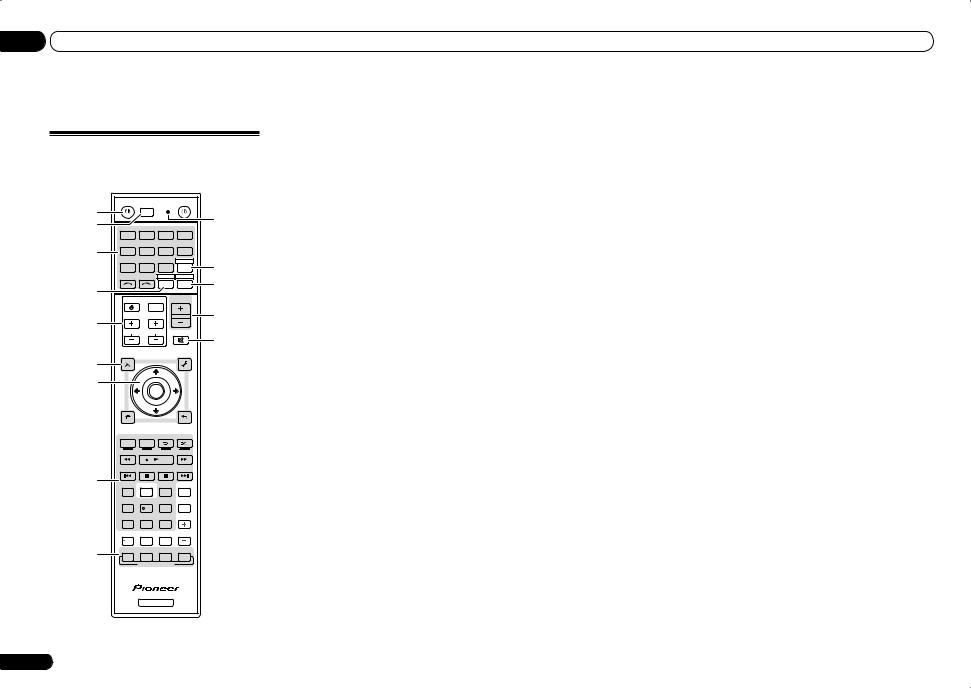
02 Controls and displays
Controls and displays
Remote control
This section explains how to operate the remote control for the receiver.
|
RECEIVER |
MULTI |
|
SOURCE |
|
|
1 |
|
OPERATION |
|
|
||
|
RCU SETUP |
|
11 |
|||
2,3 |
|
|
||||
|
|
|
BDR |
|
|
|
|
BD |
DVD |
DVR |
HDMI |
|
|
4 |
SAT |
|
|
|
|
|
TV |
CD |
|
HMG |
ADPT |
|
|
|
USB |
|
|
|
TV CTRL |
12 |
|
iPod |
TUNER |
SIRIUS |
|
||
|
INPUT SELECT |
ZONE 2 |
RECEIVER |
13 |
||
5 |
|
|
|
|
|
|
|
|
INPUT |
MASTER |
|
||
|
|
|
VOLUME |
|
||
6 |
TV CONTROL |
|
14 |
|||
CH |
|
VOL |
|
|
||
|
|
MUTE |
15 |
|||
|
|
|
|
|
|
|
|
AUDIO |
|
|
|
VIDEO |
|
7 |
PARAMETER |
|
|
PARAMETER |
|
|
LIST |
TUNE TOOLS |
|
||||
|
TOP MENU |
|
|
|
T.EDIT |
|
8 |
BAND |
|
|
|
GUIDE |
|
PRESET |
|
ENTER |
PRESET |
|
||
|
|
|
||||
|
CATEGORY |
|
|
|
RETURN |
|
|
HOME |
TUNE |
|
|
||
|
MENU |
|
|
|||
|
iPod CTRL |
|
|
|
|
|
|
|
PGM |
MEMORY MENU |
|
||
|
HDD |
DVD |
|
|
|
|
|
|
PHASE CTRL |
STATUS |
|
||
|
TV/DTV |
MPX |
PQLS |
|
|
|
9 |
S.RETRIEVER |
|
|
|
AUDIO |
|
|
1 |
2 |
|
3 |
|
|
|
SIGNAL SEL MCACC |
SLEEP |
INFO |
|
||
|
4 |
5 |
|
6 |
DISP |
|
|
CH LEVEL A.ATT |
DIMMER |
|
|||
|
7 |
8 |
|
9 |
|
|
|
D.ACCESS |
|
|
CLASS |
CH |
|
|
/CLR |
0 |
|
ENTER |
|
|
10 |
AUTO/ALC/ |
|
|
|
|
|
DIRECT |
STEREO STANDARD ADV SURR |
|
||||
LISTENING MODE
RECEIVER
The remote has been conveniently color-coded according to component control using the following system:
!White – Receiver control, TV control
!Blue – Other controls (See pages 28, 29, 31, 33 and 56.)
1 uRECEIVER
This switches between standby and on for this receiver.
2 MULTI OPERATION
Use this button to perform multi operations (page 54).
3 RCU SETUP
Use to input the preset code when making remote control settings and to set the remote control mode (page 52).
4 Input function buttons
Press to select control of other components (page 52).
Use INPUT SELECT c/ d to select the input function (page 28).
5 ZONE 2
Switch to perform operations in ZONE 2 (page 49).
6 TV CONTROL buttons
These buttons are dedicated to control the TV assigned to the TV CTRL button.
7 Receiver setting buttons
Press 



 first to access:
first to access:
!AUDIO PARAMETER – Use to access the Audio options (page 46).
!VIDEO PARAMETER – Use to access the Video options (page 48).
!HOME MENU – Use to access the Home Menu (pages 24, 25, 43, 58 and 64).
!RETURN – Press to confirm and exit the current menu screen.
8 i/j/k/l/ENTER
Use the arrow buttons when setting up your surround sound system (see page 58) and the Audio or Video options (page 46 or 48).
9Receiver Control buttons
Press 



 first to access:
first to access:
!PHASE CTRL – Press to switch on/off Phase Control (page 37).
!STATUS – Press to check selected receiver settings (page 50).
!PQLS – Press to select the PQLS setting (page 44).
!S.RETRIEVER – Press to restore CD quality sound to compressed audio sources (page 46).
!SIGNAL SEL – Use to select an input signal (page 36).
!MCACC – Press to switch between MCACC presets (page 36).
!SLEEP – Use to put the receiver in sleep mode and select the amount of time before sleep (page 50).
!CH LEVEL – Press repeatedly to select a channel, then use k/lto adjust the level (page 65).
!A.ATT – Attenuates (lowers) the level of an analog input signal to prevent distortion (page 50).
!DIMMER – Dims or brightens the display (page 50).
10LISTENING MODE controls
!AUTO/ALC/DIRECT – Switches between Auto Surround (page 35), Auto Level Control mode and Stream Direct mode (page 36).
!STEREO – Press to select stereo playback mode (page 35).
!STANDARD – Press for Standard decoding and to switch various modes (2Pro Logic, Neo:6, etc.) (page 35).
!ADV SURR – Use to switch between the various surround modes (page 35).
11 Remote control LED
Lights when a command is sent from the remote control.
12 TV CTRL
Set the preset code of your TV’s manufacturer when controlling the TV (page 52).
13 
Switches the remote to control the receiver (used to select the white commands).
Switch to perform operations in the main zone. Also use this button to set up surround sound.
14MASTER VOLUME +/–
Use to set the listening volume.
15MUTE
Mutes the sound or restores the sound if it has been muted (adjusting the volume also restores the sound).
8 En
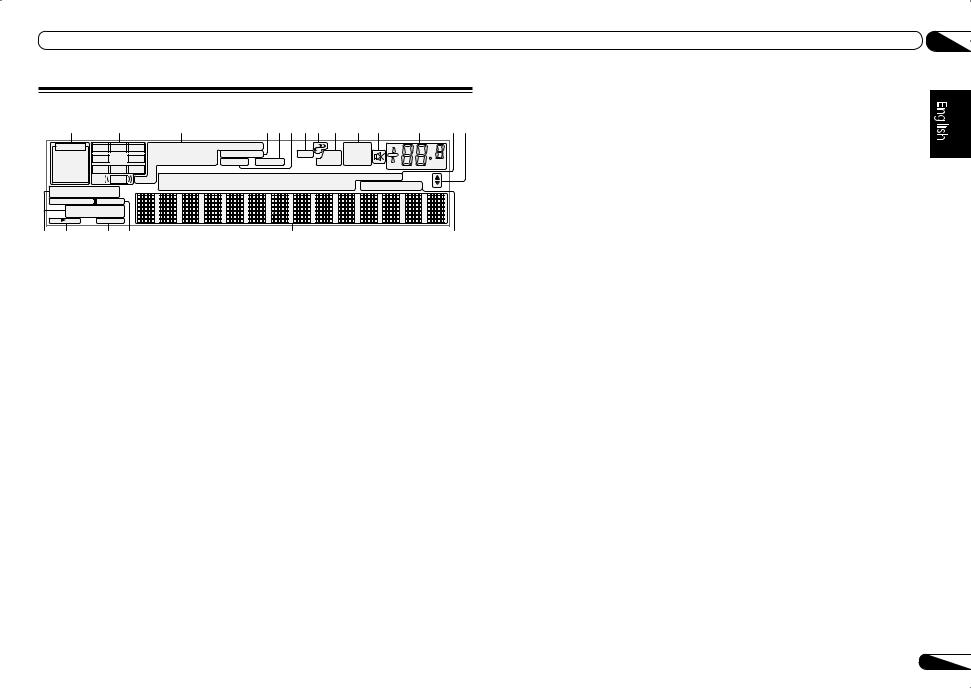
Controls and displays |
02 |
Display |
|
|
|
|
|
|
|
|
|
|
|
|
|
|
|
|
|
|
|
|
1 |
|
2 |
|
3 |
|
|
4 |
5 |
6 |
7 |
8 |
9 |
|
10 |
11 |
|
12 |
13 14 |
AUTO |
L |
C |
R |
2DIGITAL PLUS |
DSD PCM |
|
|
|
|
|
TUNED |
|
|
|
|
||||
|
|
SL |
|
SR |
2TrueHD |
|
MULTI-ZONE |
PQLS |
ALC |
|
ATT |
STEREO |
|
|
|
|
|||
HDMI |
|
DTS HD ES 96/24 |
S.RTRV |
SOUND UP MIX OVER MONO |
|
|
|
dB |
|||||||||||
DIGITAL |
XL |
XC |
XR |
|
|
|
|
|
|
|
|
|
|
|
|
|
|
|
|
ANALOG |
|
LFE |
|
CD |
TUNER |
SIRIUS |
|
DVD |
TV |
|
VIDEO HMG USB |
|
|
||||||
|
|
|
MSTR CD-R |
|
iPod |
|
BD |
DVR |
|
HDMI |
[ 2 ] |
[ 3 ] |
[ 4 ] |
|
|||||
AUTO SURROUND |
|
|
|
|
|
|
|
|
|
|
|
|
|
|
|
|
|||
STREAM DIRECT |
|
|
|
|
|
|
|
|
|
|
|
|
|
|
|
|
|||
2PROLOGIC |
x Neo:6 |
|
|
|
|
|
|
|
|
|
|
|
|
|
|
|
|
||
|
ADV.SURROUND |
|
|
|
|
|
|
|
|
|
|
|
|
|
|
|
|
||
|
STANDARD |
|
|
|
|
|
|
|
|
|
|
|
|
|
|
|
|
||
SP |
AB |
SLEEP |
|
|
|
|
|
|
|
|
|
|
|
|
|
|
|
|
|
7 |
15 |
16 |
17 |
|
|
|
|
|
18 |
|
|
|
|
|
|
|
|
19 |
|
1 Signal indicators
Light to indicate the currently selected input signal. AUTO lights when the receiver is set to select the input signal automatically (page 36).
2 Program format indicators
Light to indicate the channels to which digital signals are being input.
!L/R – Left front/Right front channel
!C – Center channel
!SL/SR – Left surround/Right surround channel
!LFE – Low frequency effects channel (the (( )) indicators light when an LFE signal is being input)
!XL/XR – Two channels other than the ones above
!XC – Either one channel other than the ones above, the mono surround channel or matrix encode flag
3 Digital format indicators
Light when a signal encoded in the corresponding format is detected.
!2DIGITAL – Lights with Dolby Digital decoding.
!2DIGITAL PLUS – Lights with Dolby Digital Plus decoding.
!2TrueHD – Lights with Dolby TrueHD decoding.
!DTS – Lights with DTS decoding.
!DTS HD – Lights with DTS-HD decoding.
!96/24 – Lights with DTS 96/24 decoding.
!DSD PCM – Light during DSD (Direct Stream Digital) to PCM conversion with SACDs.
!PCM – Lights during playback of PCM signals.
!MSTR – Lights during playback of DTS-HD Master Audio signals.
4 MULTI-ZONE
Lights when the MULTI-ZONE feature is active (page 49).
5 SOUND
Lights when the DIALOG E (Dialog Enhancement) or TONE (tone controls) features is selected (page 46).
6 S.RTRV
Lights when the Sound Retriever function is active (page 46).
7Listening mode indicators
!AUTO SURROUND – Lights when the Auto Surround feature is switched on (page 35).
!ALC – Lights when the ALC (Auto level control) mode is selected (page 35).
!STREAM DIRECT – Lights when Direct/Pure Direct is selected (page 36).
!ADV.SURROUND – Lights when one of the Advanced Surround modes has been selected (page 35).
!STANDARD – Lights when one of the Standard Surround modes is switched on (page 35).
8  (PHASE CONTROL)
(PHASE CONTROL)
Lights when the Phase Control is switched on (page 37).
9 Analog signal indicators
Light to indicate reducing the level of an analog signal (page 50).
10 Tuner indicators
!TUNED – Lights when a broadcast is being received.
!STEREO – Lights when a stereo FM broadcast is being received in auto stereo mode.
!MONO – Lights when the mono mode is set using MPX.
11 
Lights when the sound is muted.
12Master volume level
Shows the overall volume level.
“---” indicates the minimum level, and “+12dB” indicates the maximum level.
13Input function indicators
Light to indicate the input function you have selected.
14 Scroll indicators
Light when there are more selectable items when making the various settings.
15 Speaker indicators
Lights to indicate the current speaker system using SPEAKERS (page 49).
16 SLEEP
Lights when the receiver is in sleep mode (page 50).
17 Matrix decoding format indicators
!2PRO LOGIC IIx – This lights to indicate 2 Pro Logic II / 2Pro Logic IIx decoding (page 35).
!Neo:6 – When one of the Neo:6 modes of the receiver is on, this lights to indicate Neo:6 processing (page 35).
18 Character display
Displays various system information.
19 Remote control mode indicator
Lights to indicate the receiver’s remote control mode setting. (Not displayed when set to 1.) (page 68)
En 9
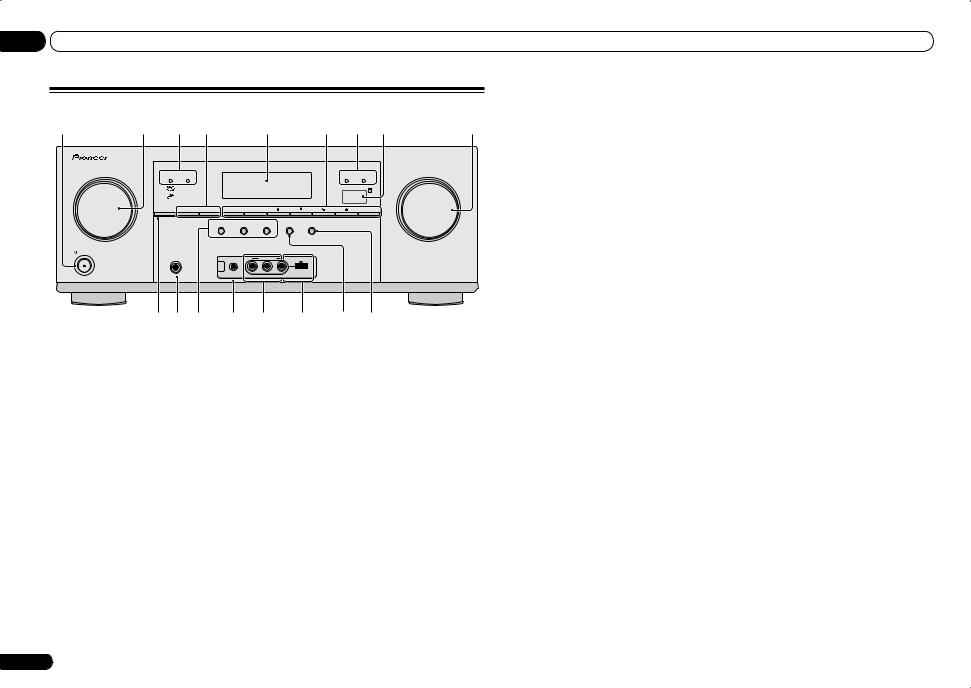
02 Controls and displays
Front panel
1 |
2 |
3 |
4 |
|
|
|
5 |
|
6 |
|
3 |
7 |
8 |
|
|
|
|
|
|
|
|
|
|
|
|
AUDIO/ VIDEO MULTI-CHANNEL RECEIVER |
VSX-1021 |
|
|
ADVANCED |
|
|
|
|
|
|
|
|
|
|
|
|
|
MCACC |
FL OFF |
|
|
|
|
|
|
HDMI |
iPod iPhone iPad |
|
|
|
SPEAKERS CONTROL – MULTI-ZONE – ON/OFF |
BAND |
TUNER EDIT |
TUNE |
|
PRESET |
ENTER |
|
|
||||
|
|
|
AUTO SURR/ALC/ |
STANDARD |
|
ADVANCED |
SOUND |
iPod iPhone iPad |
|
|
|
|
|
|
|
|
STREAM DIRECT |
SURROUND |
|
SURROUND |
RETRIEVER AIR |
DIRECT CONTROL |
|
|
|
|
|
|
INPUT |
|
|
|
|
|
|
|
|
|
|
|
MASTER |
|
SELECTOR |
|
|
|
|
|
|
|
|
|
|
|
VOLUME |
|
STANDBY/ON |
|
|
|
|
|
|
|
|
|
|
|
|
|
|
PHONES |
|
|
|
|
VIDEO 2 INPUT |
5V |
2.1 A |
|
|
|
|
|
|
|
|
|
|
|
|
|
|
|
|
||
|
|
|
|
|
|
|
|
iPod |
USB |
|
|
|
|
|
|
|
|
MCACC |
|
|
iPhone |
|
|
|
|
||
|
|
|
|
SETUP MIC |
L |
AUDIO R |
VIDEO iPad |
|
|
|
|
|
|
|
9 |
10 |
11 |
12 |
|
13 |
14 |
15 |
16 |
|
|
||
1 uSTANDBY/ON
This switches between standby and on for this receiver.
2INPUT SELECTOR dial
Use to select an input function.
3Indicators
!ADVANCED MCACC – Lights when EQ is set to ON in the AUDIO PARAMETER menu (page 46).
!FL OFF – Lights when “off” (nothing displayed) is selected with the display’s dimmer adjustment (page 50).
!HDMI – Blinks when connecting an HDMIequipped component; lights when the component is connected (page 16).
!iPod iPhone iPad – Lights to indicate iPod/ iPhone/iPad is connected (page 21).
4MULTI-ZONE controls
If you’ve made MULTI-ZONE connections (page 20) use these controls to control the sub zone from the main zone (page 49).
5 Character display
See Display on page 9 .
6TUNER controls
!BAND – Switches between AM and FM radio bands (page 31).
!TUNER EDIT – Use with TUNE i/j, PRESET k/land ENTER to memorize and name stations for recall (page 31).
!TUNE i/j– Find radio frequencies (page 31).
!PRESET k/l– Find preset stations (page 31).
7Remote sensor
Receives the signals from the remote control (page 6).
8MASTER VOLUME dial
9SPEAKERS
Use to change the speaker terminal (page 49).
10 PHONES jack
Use to connect headphones. When the headphones are connected, there is no sound output from the speakers.
11 Listening mode buttons
!AUTO SURR/ALC/STREAM DIRECT –
Switches between Auto Surround (page 35), Auto Level Control and Stream Direct mode (page 36).
!STANDARD SURROUND – Press for Standard decoding and to switch various modes (2Pro Logic, Neo:6, Stereo etc.) (page 35).
!ADVANCED SURROUND – Use to switch between the various surround modes (page 35).
12 MCACC SETUP MIC jack
Use to connect the supplied microphone (page 24).
13 AUDIO/VIDEO input
See Connecting to the front panel video terminal on page 21 .
14 iPod iPhone iPad USB terminals
Use to connect your Apple iPod/iPhone/iPad as an audio and video source (page 21), or connect a USB device for audio and photo playback (page 21).
15 SOUND RETRIEVER AIR
When the button is pressed, the input switches to ADAPTER PORT and the listening mode is automatically set to SOUND RETRIEVER AIR (page 34).
16 iPod iPhone iPad DIRECT CONTROL
Change the receiver’s input to the iPod and enable iPod operations on the iPod (page 29).
10 En
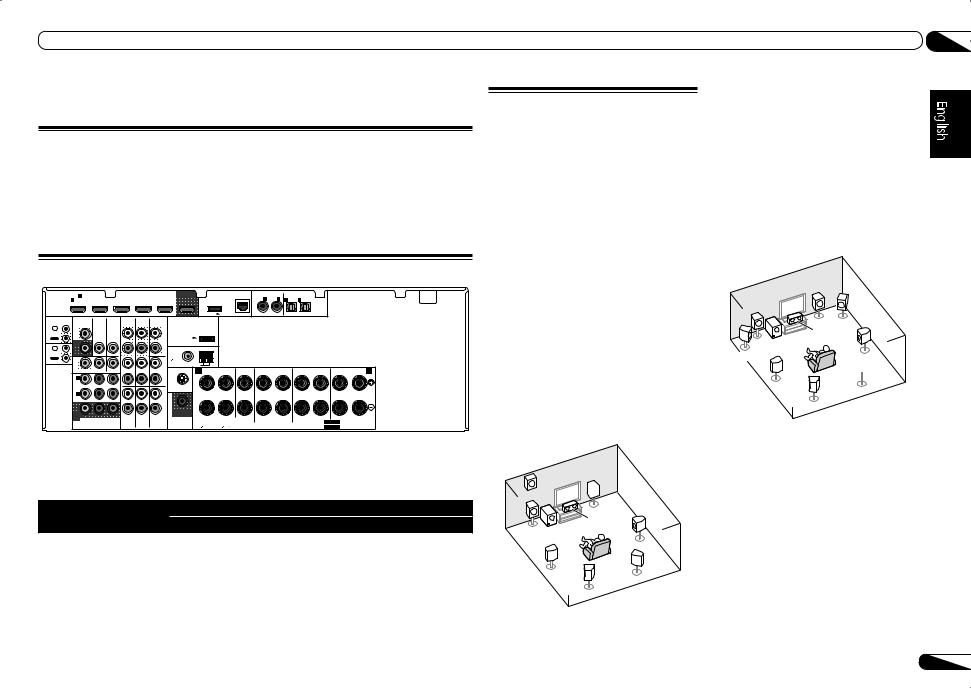
Connecting your equipment
Connecting your equipment
This receiver provides you with many connection possibilities, but it doesn’t have to be difficult. This chapter explains the kinds of components you can connect to make up your home theater system.
 CAUTION
CAUTION
Before making or changing the connections, switch off the power and disconnect the power cord from the power outlet. Plugging in should be the final step.
Rear panel |
|
|
|
|
|
|
|
|
|
|
|
||
HDMI |
IN 1 |
VIDEO 1 IN |
BD IN |
DVD IN |
DVR/BDR IN |
OUT |
|
LAN(10/100) COAXIAL ASSIGNABLE |
IN |
IN |
|
||
ASSIGNABLE 1 |
|
|
|
|
|
|
DC OUTPUT |
IN 1 |
IN 2 |
1 |
2 |
OPTICAL |
|
|
|
|
|
|
|
|
forWIRELESS LAN |
|
|
|
|
||
|
|
|
|
|
|
|
|
|
|
|
|
|
ASSIGNABLE |
|
|
|
|
|
|
|
(OUTPUT 5V |
0.6 A MAX) |
(DVD) |
(CD) |
(TV/SAT) |
(DVR/BDR) |
|
CONTROL |
VIDEO |
|
|
AUDIO |
|
|
|
|
|
|
|
|
|
|
|
|
|
|
|
IN |
ZONE 2 |
|
|
DVR/BDR CD-R/TAPE |
ZONE 2 |
|
|
|
|
|
|
|
|
|
|
|
|
|
|
|
|
|
|
|
|
|
ADAPTER PORT |
|
|
|
|
|
|
|
|
||||
|
OUT |
|
TV/SAT |
VIDEO 1 |
|
L |
|
|
|
|
|
|
|
|
|
||||
OUT |
|
|
|
|
|
(OUTPUT 5 V |
|
|
|
|
|
|
|
|
|
|
|
||
|
MONITOR |
|
IN |
IN |
OUT |
OUT |
|
0.1 A MAX) |
|
|
|
|
|
|
|
|
|
|
|
IR IN |
OUT |
|
|
|
|
R ANTENNA |
|
|
|
|
|
|
|
|
|
|
|
||
|
|
|
|
|
|
|
|
|
|
|
|
|
|
|
|
||||
OUT |
DVR/ |
|
|
|
|
CD |
FM UNBAL |
|
|
|
|
|
|
|
|
|
|
|
|
|
BDR |
|
|
|
|
L |
75 |
AM LOOP |
|
|
|
|
|
|
|
|
|
|
|
|
OUT |
IN |
DVD IN |
IN |
IN |
SIRIUS |
A |
R |
FRONT |
CENTER |
R |
SURROUND |
SURROUND BACK / ZONE 2 |
FRONT HEIGHT / WIDE / |
B |
||||
|
|
|
|
|
|
|
|
|
|
|
L |
L |
R |
L(Single) |
R |
L |
|
||
|
IN 1 |
|
|
|
|
R |
|
|
|
|
|
|
|
|
|
|
|
|
|
|
(DVD) |
|
|
|
|
|
|
|
|
|
|
|
|
|
|
|
|
|
|
|
ASSIGN |
|
|
|
|
|
|
IN |
|
|
|
|
|
|
|
|
|
|
|
|
ABLE |
|
|
|
|
|
|
|
|
|
|
|
|
|
|
|
|
|
|
|
IN 2 |
|
|
|
|
L |
|
|
|
|
|
|
|
|
|
|
|
|
|
|
(DVR/ |
|
|
|
|
|
|
|
|
|
|
|
|
|
|
|
|
|
|
|
BDR) |
|
|
|
IN |
IN |
|
|
|
|
|
|
|
|
|
|
|
|
|
|
|
|
|
|
|
R |
|
SUBWOOFER |
|
|
|
|
|
|
|
|
|
|
|
|
MONITOR |
|
|
|
|
|
|
|
|
|
|
|
|
|
|
|
|
|
|
|
OUT |
Y |
PB |
PR |
TV/SAT VIDEO 1 |
DVD |
|
|
CAUTION: |
ATTENTION: |
|
|
|
|
|
|
|
||
|
|
|
|
|
|
|
SELECTABLE SEE INSTRUCTION MANUAL |
||||||||||||
|
COMPONENT VIDEO |
|
|
|
PRE OUT |
SPEAKER IMPEDANCE ENCEINTE D’IMPEDANCE DE |
|
SPEAKERS |
Class 2Wiring SELECTABLE VOIR LE MODE D’EMPLOI |
|
|||||||||
|
|
|
|
6 -16 . |
|
6 |
-16 . |
|
|
||||||||||
 Note
Note
The input functions below are assigned by default to the receiver’s different input terminals. Refer to The Input Setup menu on page 25 to change the assignments if other connections are used.
Input function |
|
Input Terminals |
|
|
Digital |
HDMI |
Component |
||
|
||||
DVD |
COAX-1 |
(DVD) |
IN 1 |
|
BD |
|
(BD) |
|
|
|
|
|
|
|
TV/SAT |
OPT-1 |
|
|
|
DVR/BDR |
OPT-2 |
(DVR/BDR) |
IN 2 |
|
VIDEO 1 |
|
(VIDEO 1) |
|
|
|
|
|
|
|
HDMI 1 |
|
IN 1 |
|
|
CD |
COAX-2 |
|
|
|
|
|
|
|
Determining the speakers’ application
This unit permits you to build various surround systems, in accordance with the number of speakers you have.
!Be sure to connect speakers to the front left and right channels (L and R).
!It is also possible to only connect one of the surround back speakers (SB) or neither.
Choose one from Plans [A] to [E] below.
 Important
Important
!The Speaker System setting must be made if you use any of the connections shown below other than [A] (see Speaker system setting on page 64 ).
!Sound does not come through simultaneously from the front height, front wide, speaker B and surround back speakers. Output speakers are different depending on the input signal or listening mode.
[A] 7.1 channel surround system (Front height)
*Default setting
! Speaker System setting: Normal(SB/FH)
 FHR
FHR
FHL
 R
R
L |
C |
SR |
|
||
|
|
|
|
SW |
|
SL |
SBR |
|
SBL |
||
|
A 7.1 ch surround system connects the left and right front speakers (L/R), the center speaker
Connecting your equipment |
03 |
(C), the left and right front height speakers (FHL/FHR), the left and right surround speakers (SL/SR), the left and right surround back speakers (SBL/SBR), and the subwoofer (SW).
It is not possible to produce sound simultaneously from the front height or front wide speakers and the surround back speakers.
This surround system produces a more true-to- life sound from above.
[B] 7.1 channel surround system (Front wide)
! Speaker System setting: Normal(SB/FW)
R
L |
|
FWR |
|
|
|
|
C |
SR |
|
|
|
|
SW |
|
FWL
 SBR
SBR
SL
SBL
This plan replaces the left and right front height speakers shown in [A] with the left and right front wide speakers (FWL/FWR).
It is not possible to produce sound simultaneously from the front height or front wide speakers and the surround back speakers.
This surround system produces a true-to-life sound over a wider area.
[C] 7.1 channel surround system & Speaker B connection
! Speaker System setting: Speaker B
En 11
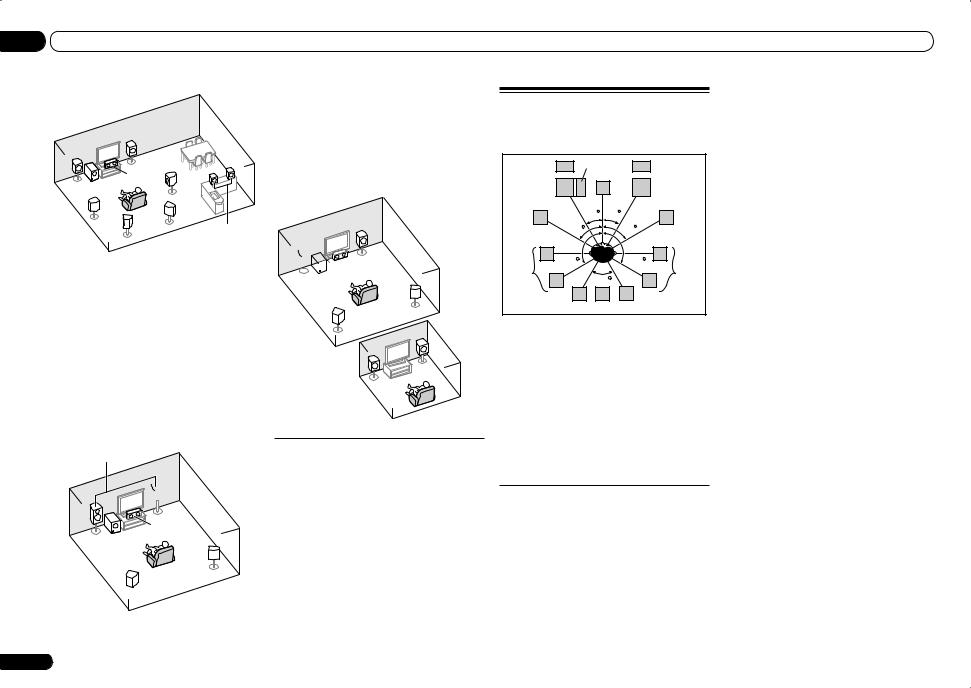
03 Connecting your equipment
|
R |
|
|
L |
|
|
|
|
C |
|
R |
|
SR |
L |
|
|
|
||
SW |
|
|
|
SL |
|
SBR |
|
|
SBL |
Speaker B |
|
|
|
With these connections you can simultaneously enjoy 5.1-channel surround sound in the main zone with stereo playback of the same sound on the B speakers. The same connections also allow for 7.1-channel surround sound in the main zone when not using the B speakers.
[D] 5.1 channel surround system & Front Bi-amping connection (High quality surround)
! Speaker System setting: Front Bi-Amp
Bi-amping connection of the front speakers for high sound quality with 5.1-channel surround sound.
Front Bi-Amp
 R
R
L
C
SW
SR
 SL
SL
[E] 5.1 channel surround system & ZONE 2 connection (Multi Zone)
! Speaker System setting: ZONE 2
With these connections you can simultaneously enjoy 5.1-channel surround sound in the main zone with stereo playback on another component in ZONE 2. (The selection of input devices is limited.)
R |
Main zone |
|
L


 C
C
SW
|
SR |
SL |
Sub zone |
|
R |
ZONE 2 |
L |
Other speaker connections
!Your favorite speaker connections can be selected even if you have fewer than 5.1 speakers (except front left/right speakers).
!When not connecting a subwoofer, connect speakers with low frequency reproduction capabilities to the front channel. (The subwoofer’s low frequency component
is played from the front speakers, so the speakers could be damaged.)
!After connecting, be sure to conduct the Full Auto MCACC (speaker environment setting) procedure. See Automatically conducting optimum sound tuning (Full Auto MCACC) on page 24 .
Placing the speakers
Refer to the chart below for placement of the speakers you intend to connect.
FHL |
SW |
C |
FHR |
|
|||
|
|
|
|
L |
|
|
R |
FWL |
30 |
30 |
FWR |
|
60 |
||
60 |
|
|
|
120 |
|
120 |
|
SL |
|
60 |
SR |
|
|
|
|
SBL |
SB SBR |
|
|
!Place the surround speakers at 120º from the center. If you, (1) use the surround back speaker, and, (2) don’t use the front height speakers / front wide speakers, we recommend placing the surround speaker right beside you.
!If you intend to connect only one surround back speaker, place it directly behind you.
!Place the left and right front height speakers at least one meter (3.3 ft.) directly above the left and right front speakers.
Some tips for improving sound quality
Where you put your speakers in the room has a big effect on the quality of the sound. The following guidelines should help you to get the best sound from your system.
!The subwoofer can be placed on the floor. Ideally, the other speakers should be at about ear-level when you’re listening to them. Putting the speakers on the floor (except the
subwoofer), or mounting them very high on a wall is not recommended.
!For the best stereo effect, place the front speakers 2 m to 3 m (6 ft. to 9 ft.) apart, at equal distance from the TV.
!If you’re going to place speakers around your CRT TV, use shielded speakers or place the speakers at a sufficient distance from your CRT TV.
!If you’re using a center speaker, place the front speakers at a wider angle. If not, place them at a narrower angle.
!Place the center speaker above or below the TV so that the sound of the center channel is localized at the TV screen. Also, make sure the center speaker does not cross the line formed by the leading edge of the front left and right speakers.
!It is best to angle the speakers towards the listening position. The angle depends on the size of the room. Use less of an angle for bigger rooms.
!Surround and surround back speakers should be positioned 60 cm to 90 cm (2 ft. to 3 ft.) higher than your ears and tilted slightly downward. Make sure the speakers don’t face each other. For DVD-Audio, the speakers should be more directly behind the listener than for home theater playback.
!Try not to place the surround speakers farther away from the listening position than the front and center speakers. Doing so can weaken the surround sound effect.
12 En
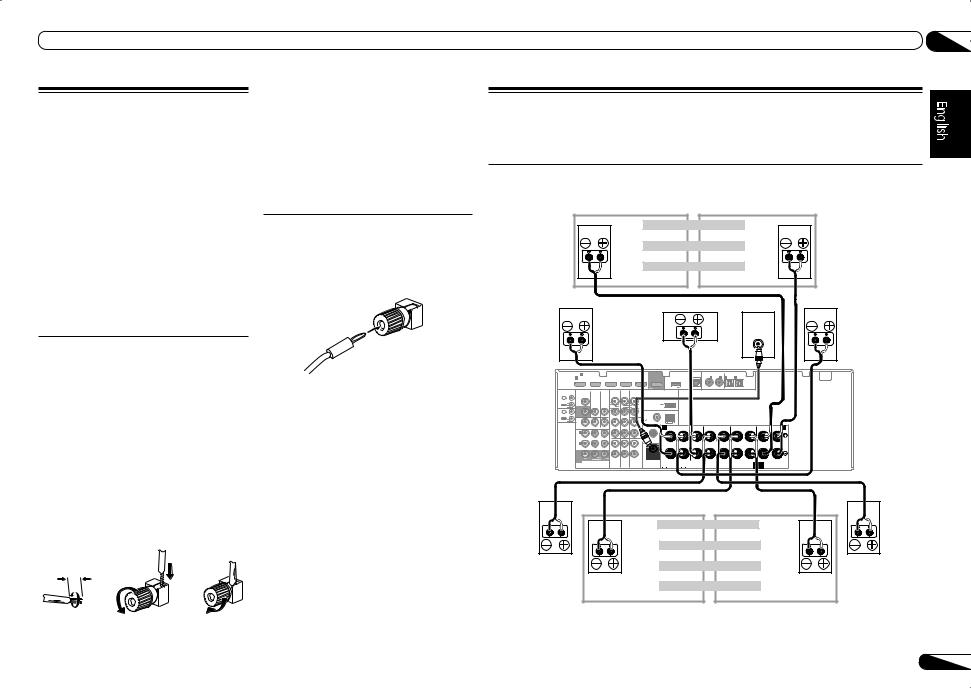
Connecting the speakers
Each speaker connection on the receiver comprises a positive (+) and negative (–) terminal. Make sure to match these up with the terminals on the speakers themselves.
 CAUTION
CAUTION
!These speaker terminals carry HAZARDOUS LIVE voltage. To prevent the risk of electric shock when connecting or disconnecting the speaker cables, disconnect the power cord before touching any uninsulated parts.
!Make sure that all the bare speaker wire is twisted together and inserted fully into the speaker terminal. If any of the bare speaker wire touches the back panel it may cause the power to cut off as a safety measure.
Bare wire connections
 CAUTION
CAUTION
Make sure that all speakers are securely installed. This not only improves sound quality, but also reduces the risk of damage or injury resulting from speakers being knocked over or falling in the event of external shocks such as earthquakes.
1Twist exposed wire strands together.
2Loosen terminal and insert exposed wire.
3Tighten terminal.
1 |
2 |
3 |
10 mm (3/8 in.)
 Note
Note
!Please refer to the manual that came with your speakers for details on how to connect the other end of the speaker cables to your speakers.
!Use an RCA cable to connect the subwoofer. It is not possible to connect using speaker cables.
Banana plug connections
If you want to use speaker cables terminated with banana plugs, screw the speaker terminal fully shut, then plug the banana plug into the end of the speaker terminal.
Connecting your equipment |
03 |
Installing your speaker system
At the very least, front left and right speakers only are necessary. Note that your main surround speakers should always be connected as a pair, but you can connect just one surround back speaker if you like (it must be connected to the left surround back terminal).
Standard surround connection
The front height terminals can also be used for the front wide and Speaker B speakers.
|
Front height setting |
|
|
|
Front height right |
Front height left |
|
|
Front wide setting |
|
|
|
Front wide right |
Front wide left |
|
|
Speaker B setting |
|
|
|
Speaker B - right |
Speaker B - left |
|
Front right |
Center |
Subwoofer |
Front left |
|
|
||
|
|
LINE LEVEL |
|
|
|
INPUT |
|
HDMI |
IN 1 |
VIDEO 1 IN |
BD IN |
DVD IN |
DVR/BDR IN |
OUT |
|
|
LAN(10/100) COAXIAL ASSIGNABLE |
IN |
IN |
|
|
|
|
||||||
|
ASSIGNABLE 1 |
|
|
|
|
|
|
|
|
DC OUTPUT |
|
IN 1 |
IN 2 |
1 |
2 |
OPTICAL |
|
|
|
||
|
|
|
|
|
|
|
|
|
|
|
forWIRELESS LAN |
|
|
|
|
|
|
|
|||
|
|
|
|
|
|
|
|
|
|
|
|
|
|
|
|
|
|
ASSIGNABLE |
|
|
|
|
|
|
|
|
|
AUDIO |
|
|
|
|
(OUTPUT 5V |
0.6 A MAX) |
(DVD) |
(CD) |
(TV/SAT) |
(DVR/BDR) |
|
|
|
||
CONTROL |
VIDEO |
|
|
|
|
|
|
|
|
|
|
|
|
|
|
|
|
|
|
||
|
IN |
ZONE 2 |
|
|
DVR/BDR CD-R/TAPE |
ZONE 2 |
|
|
|
|
|
|
|
|
|
|
|
|
|
||
|
|
|
|
|
|
|
|
|
ADAPTER PORT |
|
|
|
|
|
|
|
|
|
|
||
|
|
OUT |
|
TV/SAT |
VIDEO 1 |
|
|
L |
|
|
|
|
|
|
|
|
|
|
|
||
|
OUT |
|
|
|
|
|
(OUTPUT 5 V |
|
|
|
|
|
|
|
|
|
|
|
|||
|
|
MONITOR |
|
IN |
IN |
OUT |
|
OUT |
|
0.1 A MAX) |
|
|
|
|
|
|
|
|
|
|
|
IR |
IN |
OUT |
|
|
|
|
|
R ANTENNA |
|
|
|
|
|
|
|
|
|
|
|
||
|
|
|
|
|
|
|
|
|
|
|
|
|
|
|
|
|
|||||
|
OUT |
DVR/ |
|
|
|
|
|
CD |
FM UNBAL |
|
|
|
|
|
|
|
|
|
|
|
|
|
|
BDR |
|
|
|
|
|
L |
75 |
AM LOOP |
|
|
|
|
|
|
|
|
|
|
|
|
|
OUT |
IN |
DVD IN |
IN |
|
|
|
A |
FRONT |
CENTER |
SURROUND |
SURROUND BACK / ZONE 2 |
FRONT HEIGHT / WIDE / |
B |
||||||
|
|
|
|
|
R |
|
L |
R |
|
L |
R |
L(Single) |
R |
L |
|||||||
|
|
IN 1 |
|
|
|
|
|
|
|
|
|
|
|
|
|
|
|
|
|
|
|
|
|
(DVD) |
|
|
|
|
|
|
|
|
|
|
|
|
|
|
|
|
|
|
|
|
|
ASSIGN |
|
|
|
|
|
|
|
IN |
|
|
|
|
|
|
|
|
|
|
|
|
|
ABLE |
|
|
|
|
|
|
|
|
|
|
|
|
|
|
|
|
|
|
|
|
|
IN 2 |
|
|
|
|
|
|
|
|
|
|
|
|
|
|
|
|
|
|
|
|
|
(DVR/ |
|
|
|
|
|
|
|
|
|
|
|
|
|
|
|
|
|
|
|
|
|
BDR) |
|
|
|
IN |
|
|
|
|
|
|
|
|
|
|
|
|
|
|
|
|
|
|
|
|
|
|
|
R |
|
|
|
|
|
|
|
|
|
|
|
|
|
MONITOR |
|
|
SUBWOOFER |
|
|
|
|
OUT Y |
PB |
PR |
TV/SAT VIDEO 1 DVD |
CAUTION: |
ATTENTION: |
|
SELECTABLE SEE INSTRUCTION MANUAL |
COMPONENT VIDEO |
PRE OUT |
SPEAKER IMPEDANCE ENCEINTE D’IMPEDANCE DE |
SPEAKERS |
Class 2Wiring SELECTABLE VOIR LE MODE D’EMPLOI |
|||
6 -16 . |
6 -16 . |
||||||
|
The surround back terminals can also be |
|
||
|
used for ZONE 2. |
|
|
|
|
5.1 ch surround setting |
|
||
|
Not connected |
Not connected |
|
|
|
6.1 ch surround setting |
|
||
Surround right |
Not connected |
Surround back |
Surround left |
|
7.1 ch surround setting |
||||
|
|
|||
|
Surround back right |
Surround back left |
|
|
|
ZONE 2 setting |
|
|
|
|
ZONE 2 - Right |
ZONE 2 - Left |
|
|
En 13
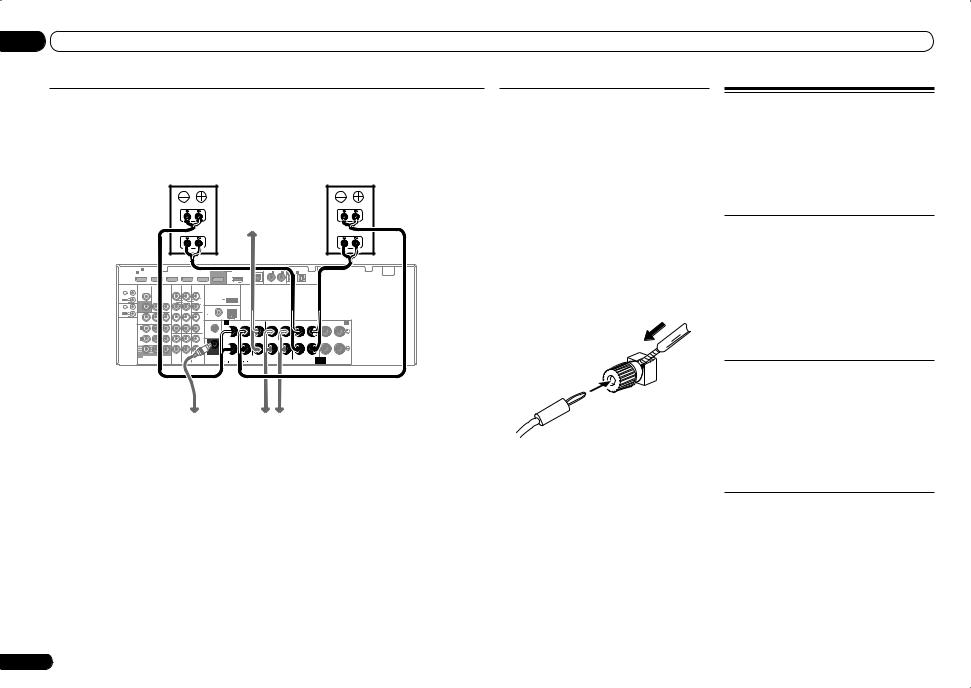
03 Connecting your equipment
Bi-amping your speakers
Bi-amping is when you connect the high frequency driver and low frequency driver of your speakers to different amplifiers for better crossover performance. Your speakers must be bi-ampable to do this (having separate terminals for high and low) and the sound improvement will depend on the kind of speakers you’re using.
|
Front right |
Front left |
|
Bi-amp compatible |
|
|
Bi-amp compatible |
speaker |
High |
High |
speaker |
|
|
Center |
|
|
Low |
Low |
|
HDMI |
IN 1 |
VIDEO 1 IN |
BD IN |
DVD IN |
DVR/BDR IN |
OUT |
LAN(10/100) COAXIAL ASSIGNABLE |
IN |
IN |
|
||
ASSIGNABLE 1 |
|
|
|
|
DC OUTPUT |
IN 1 |
IN 2 |
1 |
2 |
OPTICAL |
||
|
|
|
|
|
|
forWIRELESS LAN |
|
|
|
|
||
|
|
|
|
|
|
|
|
|
|
|
|
ASSIGNABLE |
|
|
|
AUDIO |
|
|
(OUTPUT 5V |
0.6 A MAX) |
(DVD) |
(CD) |
(TV/SAT) |
(DVR/BDR) |
|
CONTROL |
VIDEO |
|
|
|
|
|
|
|
|
|
|
|
|
IN |
ZONE 2 |
|
|
DVR/BDR CD-R/TAPE |
ZONE 2 |
|
|
|
|
|
|
|
ADAPTER PORT |
|
|
|
OUT |
TV/SAT |
VIDEO 1 |
L |
||
|
OUT |
|
|
(OUTPUT 5 V |
|||
|
|
MONITOR |
IN |
IN |
OUT |
OUT |
0.1 A MAX) |
IR |
IN |
OUT |
|
|
|
R ANTENNA |
|
|
|
|
|
||||
OUT |
DVR/ |
|
|
|
|
CD |
FM UNBAL |
|
|
|
|
|
|
|
|
|
|
|
|
|
|
BDR |
OUT |
IN |
DVD IN |
IN |
L |
75 |
AM LOOP |
R |
|
L |
R |
L |
R |
L(Single) |
R |
L |
B |
||
|
|
IN |
SIRIUS |
A |
|
|||||||||||||||
|
|
|
|
|
|
|
|
|
|
FRONT |
CENTER |
|
SURROUND |
SURROUND BACK / ZONE 2 |
FRONT HEIGHT / WIDE / |
|
||||
|
IN 1 |
|
|
|
|
R |
|
|
|
|
|
|
|
|
|
|
|
|
|
|
|
(DVD) |
|
|
|
|
|
|
|
|
|
|
|
|
|
|
|
|
|
|
|
|
ASSIGN |
|
|
|
|
|
|
IN |
|
|
|
|
|
|
|
|
|
|
|
|
|
ABLE |
|
|
|
|
|
|
|
|
|
|
|
|
|
|
|
|
|
|
|
|
IN 2 |
|
|
|
|
L |
|
|
|
|
|
|
|
|
|
|
|
|
|
|
|
(DVR/ |
|
|
|
|
|
|
|
|
|
|
|
|
|
|
|
|
|
|
|
|
BDR) |
|
|
|
IN |
|
|
|
|
|
|
|
|
|
|
|
|
|
|
|
|
MONITOR |
|
|
|
|
|
SUBWOOFER |
|
|
|
|
|
|
|
|
|
|
|
|
|
|
OUT |
Y |
PB |
PR |
TV/SAT VIDEO 1 |
|
|
|
CAUTION: |
ATTENTION: |
|
|
|
|
SELECTABLE SEE INSTRUCTION MANUAL |
|||||
|
COMPONENT VIDEO |
|
|
|
PRE OUT |
SPEAKER IMPEDANCE |
ENCEINTE D’IMPEDANCE DE |
|
SPEAKERS |
Class 2Wiring |
SELECTABLE VOIR LE MODE D’EMPLOI |
|
||||||||
|
|
|
|
6 -16 . |
|
6 |
-16 . |
|
|
|||||||||||
Bi-wiring your speakers
Your speakers can also be bi-wired if they support bi-amping.
!With these connections, the Speaker System setting makes no difference.
 CAUTION
CAUTION
!Don’t connect different speakers from the same terminal in this way.
!When bi-wiring as well, heed the cautions for bi-amping shown above.
% To bi-wire a speaker, connect two speaker cords to the speaker terminal on the receiver.
Using a banana plug for the second connection is recommended.
Subwoofer |
Surround right |
Surround left |
 CAUTION
CAUTION
!Most speakers with both High and Low terminals have two metal plates that connect the High to the Low terminals. These must be removed when you are bi-amping the speakers or you could severely damage the amplifier. See your speaker manual for more information.
!If your speakers have a removable crossover network, make sure you do not remove it for bi-amping. Doing so may damage your speakers.
Selecting the Speaker system
The front height terminals can be used for front wide and Speaker B connections, in addition to for the front height speakers. Also, the surround back terminals can be used for bi-amping and ZONE 2 connections, in addition to for the surround back speakers. Make this setting according to the application.
Front height setup
*Default setting
1Connect a pair of speakers to the front height speaker terminals.
See Standard surround connection on page 13 .
2If necessary, select ‘Normal(SB/FH)’ from the Speaker System menu.
See Speaker system setting on page 64 to do this.
Front wide setup
1Connect a pair of speakers to the front height speaker terminals.
See Standard surround connection on page 13 .
2Select ‘Normal(SB/FW)’ from the Speaker System menu.
See Speaker system setting on page 64 to do this.
Speaker B setup
You can listen to stereo playback in another room.
1Connect a pair of speakers to the front height speaker terminals.
See Standard surround connection on page 13 .
2Select ‘Speaker B’ from the
Speaker System menu.
See Speaker system setting on page 64 to do this.
14 En
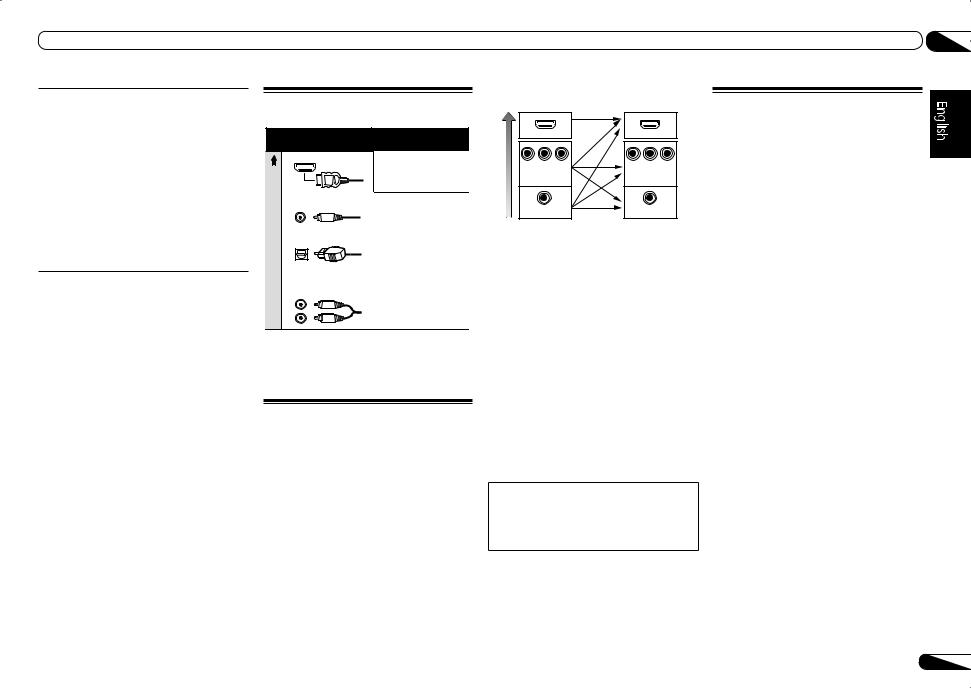
Connecting your equipment |
03 |
Bi-Amping setup
Bi-amping connection of the front speakers for high sound quality with 5.1-channel surround sound.
1Connect bi-amp compatible speakers to the front and surround back speaker terminals.
See Bi-amping your speakers on page 14 .
2Select ‘Front Bi-Amp’ from the Speaker System menu.
See Speaker system setting on page 64 to do this.
ZONE 2 setup
With these connections you can simultaneously enjoy 5.1-channel surround sound in the main zone with stereo playback on another component in ZONE 2.
1Connect a pair of speakers to the surround back speaker terminals.
See Standard surround connection on page 13 .
2Select ‘ZONE 2’ from the
Speaker System menu.
See Speaker system setting on page 64 to do this.
About the audio connection
Types of cables and |
Transferable audio |
terminals |
signals |
|
HDMI |
HD audio |
priority |
|
|
Sound signal |
Digital (Coaxial) |
Conventional digital audio |
Digital (Optical) |
|
|
|
RCA (Analog) |
Conventional analog audio |
|
(White/Red) |
|
!With an HDMI cable, video and audio signals can be transferred in high quality over a single cable.
About the video converter
The video converter ensures that all video sources are output through all of the MONITOR VIDEO OUT jacks. The only exception is HDMI: since this resolution cannot be downsampled, you must connect your monitor/TV to the receiver’s HDMI output when connecting this video source.
If several video components are assigned to the same input function (see The Input Setup menu on page 25 ), the converter gives priority to HDMI, component, then composite (in that order).
|
Terminal for connection with |
Terminal for connection |
||||
|
source device |
with TV monitor |
||||
quality |
|
HDMI IN |
|
|
HDMI OUT |
|
picture |
|
|
|
|
|
|
High |
Y |
PB |
PR |
Y |
PB |
PR |
|
|
COMPONENT |
COMPONENT VIDEO |
|||
|
|
VIDEO IN |
|
MONITOR OUT |
||
|
|
VIDEO IN |
|
|
VIDEO |
|
|
|
|
|
MONITOR OUT |
||
 Video signals can be output
Video signals can be output
 Note
Note
!If the video signal does not appear on your TV, try adjusting the resolution settings on your component or display. Note that some components (such as video game units) have resolutions that may not be converted. In this case, try switching Digital Video Conversion (in Setting the Video options on page 48 ) OFF.
!The signal input resolutions that can be converted from the component video input for the HDMI output are 480i/576i, 480p/576p, 720p and 1080i. 1080p signals cannot be converted.
!Only signals with an input resolution of 480i/576i can be converted from the
component video input for the composite
MONITOR OUT terminals.
This item incorporates copy protection technology that is protected by U.S. patents and other intellectual property rights of Rovi Corporation. Reverse engineering and disassembly are prohibited.
About HDMI
The HDMI connection transfers uncompressed digital video, as well as almost every kind of digital audio.
This receiver incorporates High-Definition Multimedia Interface (HDMI®) technology. This receiver supports the functions described below through HDMI connections.
!Digital transfer of uncompressed video (contents protected by HDCP (1080p/24, 1080p/60, etc.))
!3D signal transfer
!Deep Color signal transfer
!x.v.Color signal transfer
!ARC (Audio Return Channel)
!Input of multi-channel linear PCM digital audio signals (192 kHz or less) for up to 8 channels
!Input of the following digital audio formats:
—Dolby Digital, Dolby Digital Plus, DTS, High bitrate audio (Dolby TrueHD, DTS-HD Master Audio, DTS-HD High Resolution Audio), DVD-Audio, CD, SACD (DSD signal), Video CD, Super VCD
!Synchronized operation with components using the Control with HDMI function (see
Control with HDMI function on page 43 )
 Note
Note
!An HDMI connection can only be made with DVI-equipped components compatible with both DVI and High Bandwidth Digital Content Protection (HDCP). If you choose to connect to a DVI connector, you will need a
separate adaptor (DVIdHDMI) to do so. A DVI connection, however, does not support audio signals. Consult your local audio dealer for more information.
En 15
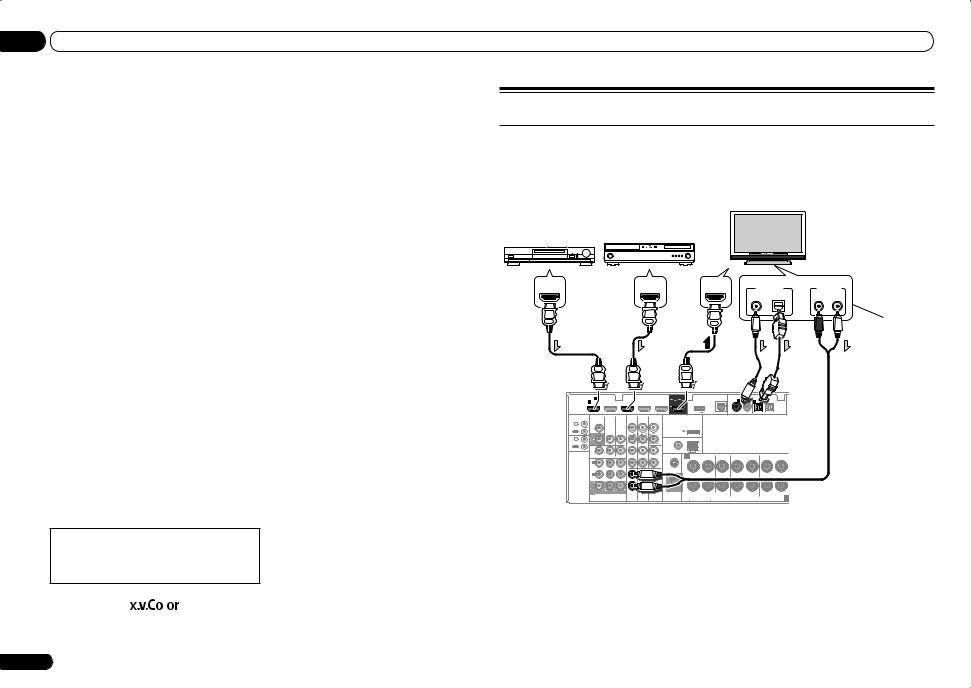
03Connecting your equipment
!If you connect a component that is not compatible with HDCP, an
HDCP ERROR message is displayed on the front panel display. Some components that are compatible with HDCP still cause this message to be displayed, but so long as there is no problem with displaying video this is not a malfunction.
!Depending on the component you have connected, using a DVI connection may result in unreliable signal transfers.
!This receiver supports SACD, Dolby Digital Plus, Dolby TrueHD and DTS-HD Master Audio. To take advantage of these formats, however, make sure that the component connected to this receiver also supports the corresponding format.
!Use a High Speed HDMI® cable. If an HDMI cable other than a High Speed HDMI® cable is used, it may not work properly.
!When an HDMI cable with a built-in equalizer is connected, it may not operate properly.
!Signal transfer is only possible when connected to a compatible component.
!HDMI format digital audio transmissions require a longer time to be recognized. Due to this, interruption in the audio may occur when switching between audio formats or beginning playback.
!Turning on/off the device connected to this unit’s HDMI OUT terminal during playback, or disconnecting/connecting the HDMI cable during playback, may cause noise or interrupted audio.
HDMI, the HDMI logo and High-Definition Multimedia Interface are trademarks or registered trademarks of HDMI Licensing, LLC in the United States and other countries.
“x.v.Color” and |
|
|
are trade- |
|
|
||
|
|||
marks of Sony Corporation. |
|
||
Connecting your TV and playback components
Connecting using HDMI
If you have an HDMI or DVI (with HDCP) equipped component (Blu-ray disc player (BD), etc.), you can connect it to this receiver using a commercially available HDMI cable.
If the TV and playback components support the Control with HDMI feature, the convenient Control with HDMI functions can be used (see Control with HDMI function on page 43 ).
Other HDMI/DVI- |
HDMI/DVI-compatible |
|
Blu-ray disc player |
||
equipped component |
||
HDMI/DVI-compatible |
||
|
||
|
monitor |
HDMI OUT |
HDMI OUT |
HDMI IN |
Select one |
|
DIGITAL OUT |
||||
|
|
|
||
|
|
|
COAXIAL OPTICAL |
AUDIO OUT
R ANALOG L
This connection is required in order to listen to the sound of the TV over the receiver.
HDMI |
IN 1 |
VIDEO 1 IN |
BD IN |
DVD IN |
DVR/BDR IN |
OUT |
|
LAN(10/100) COAXIAL |
|
|
|
|
|
ASSIGNABLE 1 |
|
|
|
|
|
|
DC OUTPUT |
IN 1 |
|
|
2 |
OPTICAL |
|
|
|
|
|
|
|
|
forWIRELESS LAN |
|
|
|
|
||
|
|
|
|
|
|
|
|
|
|
|
|
|
ASSIGNABLE |
|
|
|
|
|
|
|
(OUTPUT 5V |
0.6 A MAX) |
(DVD) |
(CD) |
(TV/SAT) |
(DVR/BDR) |
|
CONTROL |
VIDEO |
|
|
AUDIO |
|
|
|
|
|
|
|
|
IN |
ZONE 2 |
|
|
DVR/BDR CD-R/TAPE |
ZONE 2 |
|
|
|
|
|
|
|
|
|
|
|
|
|
ADAPTER PORT |
|
|
|
|
|
|
|
OUT |
TV/SAT |
VIDEO 1 |
|
L |
|
|
|
|
|
|
|
OUT |
|
|
|
(OUTPUT 5 V |
|
|
|
|
|
|||
MONITOR |
IN |
IN |
OUT |
OUT |
0.1 A MAX) |
|
|
|
|
|
||
IR IN |
OUT |
|
|
|
R ANTENNA |
|
|
|
|
|
||
|
|
|
|
|
|
|
|
|
||||
OUT |
DVR/ |
|
|
|
CD |
FM UNBAL |
|
|
|
|
|
|
|
BDR |
IN |
DVD IN IN |
L |
75 |
AM LOOP |
L |
R |
L |
R |
L(Single) |
|
|
OUT |
IN |
SIRIUS |
A R |
||||||||
|
|
|
|
|
|
|
FRONT |
|
CENTER |
SURROUND |
SURROUND BACK / ZONE 2 |
|
|
IN 1 |
|
|
|
R |
|
|
|
|
|
|
|
|
(DVD) |
|
|
|
|
|
|
|
|
|
|
|
|
ASSIGN |
|
|
|
|
IN |
|
|
|
|
|
|
|
ABLE |
|
|
|
|
|
|
|
|
|
|
|
|
IN 2 |
|
|
|
|
|
|
|
|
|
|
|
|
(DVR/ |
|
|
|
|
|
|
|
|
|
|
|
|
BDR) |
|
|
IN |
|
|
|
|
|
|
|
|
MONITOR |
|
|
|
|
SUBWOOFER |
|
|
|
|
|
|
OUT |
Y |
PB |
PR |
TV/SAT VIDEO 1 |
DVD |
|
CAUTION: |
ATTENTION: |
|
|
|
|
|
|
|
SEL |
|||||||
|
COMPONENT VIDEO |
|
|
PRE OUT |
SPEAKER IMPEDANCE ENCEINTE D’IMPEDANCE DE |
SPEAKERS |
Class 2Wiring |
SEL |
|||
|
|
|
6 -16 . |
6 -16 . |
|||||||
!For input components, connections other than HDMI connections are also possible (see
Connecting your DVD player with no HDMI output on page 17 ).
!If you want to listen to the sound of the TV over the receiver, connect the receiver and TV with audio cables.
—When the TV and receiver are connected by HDMI connections, if the TV supports the HDMI ARC (Audio Return Channel) function, the sound of the TV is input to the receiver via the HDMI OUT terminal, so there is no need to connect an audio cable. In this case, set TV Audio at HDMI Setup to via HDMI (see HDMI Setup on page 43 ).
16 En
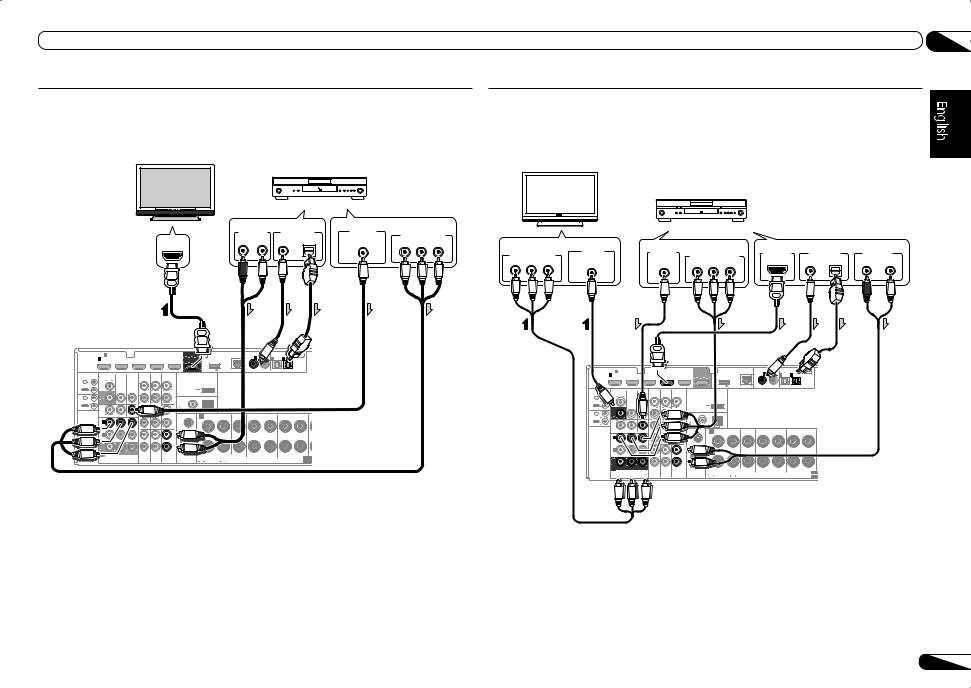
Connecting your equipment |
03 |
Connecting your DVD player with no HDMI output
This diagram shows connections of a TV (with HDMI input) and DVD player (or other playback component with no HDMI output) to the receiver.
HDMI/DVI-compatible monitor
|
|
DVD player, etc. |
|
|
|
|
|
|
Select one |
VIDEO OUT |
Select one |
|
|
||
|
AUDIO OUT |
DIGITAL OUT |
COMPONENT VIDEO OUT |
||||
|
R ANALOG L |
COAXIAL OPTICAL |
VIDEO |
||||
HDMI IN |
PR |
PB |
Y |
||||
|
|||||||
Connecting your TV with no HDMI input
This diagram shows connections of a TV (with no HDMI input) and DVD player (or other playback component) to the receiver.
!With these connections, the picture is not output to the TV even if the DVD player is connected with an HDMI cable. Connect the DVD player’s video signals using a composite or component cord.
|
|
|
|
|
DVD player, etc. |
|
|
|
|
|
|
|
|
|
TV |
|
|
|
|
|
|
|
|
Select one |
VIDEO IN |
VIDEO OUT |
Select one |
|
HDMI OUT |
Select one |
AUDIO OUT |
|
COMPONENT VIDEO IN |
COMPONENT VIDEO OUT |
DIGITAL OUT |
||||||||
PR |
PB |
Y |
VIDEO |
VIDEO |
|
COAXIAL OPTICAL |
R ANALOG L |
|||
PR |
PB |
Y |
|
|||||||
HDMI |
IN 1 |
VIDEO 1 IN |
BD IN |
DVD IN |
DVR/BDR IN |
OUT |
|
LAN(10/100) COAXIAL |
|
|
IN |
|
|
ASSIGNABLE 1 |
|
|
|
|
|
|
DC OUTPUT |
IN 1 |
|
|
2 |
OPTICAL |
|
|
|
|
|
|
|
|
forWIRELESS LAN |
|
|
|
|
||
|
|
|
|
|
|
|
|
|
|
|
|
|
ASSIGNABLE |
|
|
|
|
|
|
|
(OUTPUT 5V |
0.6 A MAX) |
(DVD) |
(CD) |
(TV/SAT) |
(DVR/BDR) |
|
CONTROL |
VIDEO |
|
|
AUDIO |
|
|
IN |
ZONE 2 |
|
|
DVR/BDR CD-R/TAPE |
ZONE 2 |
|
|
|
|
|
|
ADAPTER PORT |
|
|
OUT |
TV/SAT |
VIDEO 1 |
|
L |
|
OUT |
|
|
|
(OUTPUT 5 V |
||
|
MONITOR |
IN |
IN |
OUT |
OUT |
0.1 A MAX) |
IR IN |
OUT |
|
|
|
R ANTENNA |
|
|
|
|
|
|||
OUT |
DVR/ |
|
|
CD |
FM UNBAL |
|
|
|
|
|
|
|
|
|
BDR |
|
|
L |
75 |
AM LOOP |
|
|
|
|
|
|
|
|
OUT |
IN |
DVD |
IN |
SIRIUS |
A |
R |
FRONT |
CENTER |
SURROUND |
SURROUND BACK / ZONE 2 |
F |
|
|
|
L |
R |
L |
R |
L(Single) |
|
||||||
IN 1 |
R |
DVD) |
|
ASSIGN
ABLE
2 |
|
|
|
|
|
|
|
|
|
|
DVR/ |
|
|
|
|
|
|
|
|
|
|
) |
|
|
IN |
|
IN |
|
|
|
|
|
|
|
|
|
|
R |
|
|
|
|
|
MONITOR |
|
|
|
|
|
|
|
|
|
|
Y |
PB |
PR |
TV/SAT VIDEO 1 |
DVD |
|
CAUTION: |
ATTENTION: |
|
|
SELECTA |
COMPONENT VIDEO |
|
|
PRE OUT |
SPEAKER IMPEDANCE ENCEINTE D’IMPEDANCE DE |
SPEAKERS |
Class 2Wiring |
SELECTA |
|||
|
|
6 -16 . |
6 -16 . |
|||||||
!If you want to listen to the sound of the TV over the receiver, connect the receiver and TV with audio cables (page 16).
—When the TV and receiver are connected by HDMI connections, if the TV supports the HDMI ARC (Audio Return Channel) function, the sound of the TV is input to the receiver via the HDMI OUT terminal, so there is no need to connect an audio cable. In this case, set TV Audio at HDMI Setup to via HDMI (see HDMI Setup on page 43 ).
!If you use an optical digital audio cable, you’ll need to tell the receiver which digital input you connected the player to (see The Input Setup menu on page 25 ).
HDMI |
IN 1 |
VIDEO 1 IN |
BD IN |
IN |
DVR/BDR IN |
OUT |
|
|
|
LAN(10/100) COAXIAL |
|
|
IN |
|
|
||||
ASSIGNABLE 1 |
|
|
|
|
|
|
|
|
|
DC OUTPUT |
|
IN 1 |
|
|
2 |
OPTICAL |
|||
|
|
|
|
|
|
|
|
|
|
|
forWIRELESS LAN |
|
|
|
|
||||
|
|
|
|
|
|
|
|
|
|
|
|
|
|
|
|
|
|
ASSIGNABLE |
|
|
|
|
|
|
AUDIO |
|
|
|
|
|
(OUTPUT 5V |
0.6 A MAX) |
(DVD) |
(CD) |
(TV/SAT) (DVR/BDR) |
|
|||
|
|
|
|
|
|
|
|
|
|
|
|
|
|
|
|
|
|
|
|
|
ZONE 2 |
|
|
DVR/BDR CD-R/TAPE |
ZONE 2 |
|
|
|
|
|
|
|
|
|
|
|
|
||
|
|
|
TV/SAT |
|
|
|
L |
|
ADAPTER PORT |
|
|
|
|
|
|
|
|
||
|
|
|
|
|
|
|
(OUTPUT 5 V |
|
|
|
|
|
|
|
|
|
|
||
|
MONITOR |
|
IN |
|
OUT |
|
OUT |
0.1 A MAX) |
|
|
|
|
|
|
|
|
|
|
|
IR IN |
OUT |
|
|
|
|
|
|
ANTENNA |
|
|
|
|
|
|
|
|
|
|
|
|
|
|
|
|
|
|
|
|
|
|
|
|
|
|
|
|
|||
OUT |
DVR/ |
|
|
|
|
|
|
UNBAL |
|
|
|
|
|
|
|
|
|
|
|
|
BDR |
|
|
|
|
|
|
|
AM LOOP |
|
|
|
|
|
|
|
|
|
|
|
OUT |
IN |
DVD IN |
IN |
|
|
SIRIUS |
R |
|
L |
R |
|
L |
R |
L(Single) |
||||
|
|
|
|
A |
|
|
|||||||||||||
|
|
|
|
|
|
|
|
|
|
|
FRONT |
CENTER |
SURROUND |
SURROUND BACK / ZONE 2 |
|||||
|
IN 1 |
|
|
|
|
|
|
|
|
|
|
|
|
|
|
|
|
|
|
|
(DVD) |
|
|
|
|
|
|
|
|
|
|
|
|
|
|
|
|
|
|
|
ASSIGN |
|
|
|
|
|
|
|
|
|
|
|
|
|
|
|
|
|
|
|
ABLE |
|
|
|
|
|
|
|
|
|
|
|
|
|
|
|
|
|
|
|
IN 2 |
|
|
|
|
|
L |
|
|
|
|
|
|
|
|
|
|
|
|
|
(DVR/ |
|
|
|
|
|
|
|
|
|
|
|
|
|
|
|
|
|
|
|
BDR) |
|
|
|
IN |
|
IN |
|
|
|
|
|
|
|
|
|
|
|
|
|
|
|
|
|
|
|
R |
|
|
|
|
|
|
|
|
|
|
|
|
|
MONITOR |
|
|
|
|
|
|
|
|
|
|
|
|
|
|
|
|
|
|
|
OUT |
Y |
PB |
PR |
TV/SAT VIDEO 1 |
DVD |
|
|
CAUTION: |
ATTENTION: |
|
|
|
|
|
|
|||
|
|
|
|
|
|
|
|
|
SELEC |
||||||||||
|
COMPONENT VIDEO |
|
|
|
PRE OUT |
SPEAKER IMPEDANCE ENCEINTE D’IMPEDANCE DE |
|
SPEAKERS |
|
Class 2Wiring |
SELEC |
||||||||
|
|
|
|
6 -16 . |
6 |
-16 . |
|
|
|||||||||||
!Connect using an HDMI cable to listen to HD audio on the receiver. Do not use an HDMI cable to input video signals.
Depending on the video component, it may not be possible to output signals connected by HDMI and other methods simultaneously, and it may be necessary to make output settings. Please refer to the operating instructions supplied with your component for more information.
!If you want to listen to the sound of the TV over the receiver, connect the receiver and TV with audio cables (page 16).
!If you use an optical digital audio cable, you’ll need to tell the receiver which digital input you connected the player to (see The Input Setup menu on page 25 ).
En 17
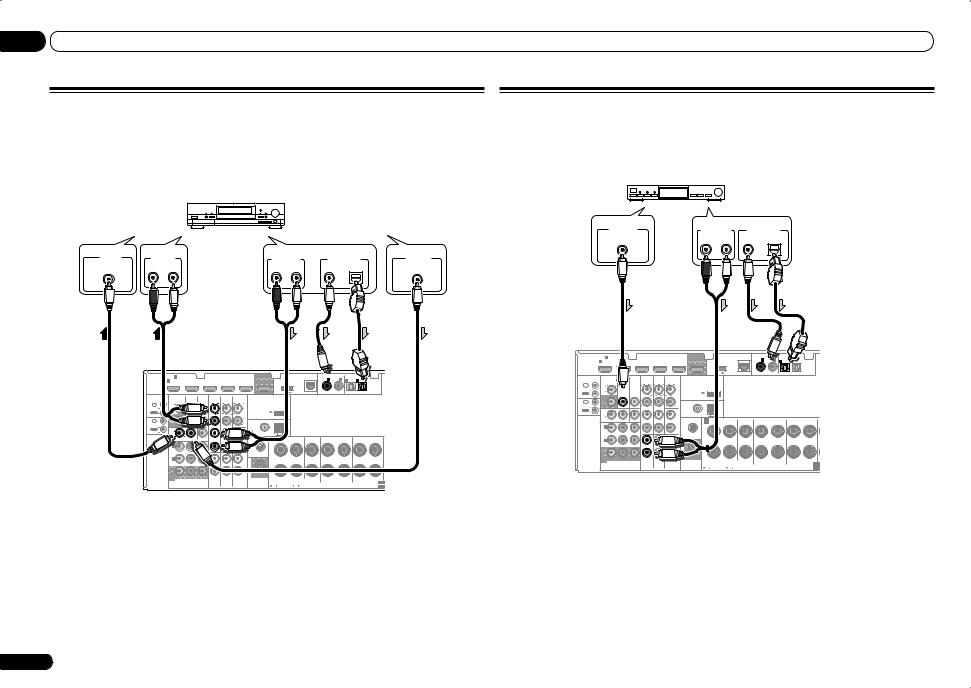
03 Connecting your equipment
Connecting an HDD/DVD recorder, BD recorder and other video sources
This receiver has two sets of audio/video inputs and outputs suitable for connecting analog or digital video devices, including HDD/DVD recorders and BD recorders.
When you set up the receiver you’ll need to tell the receiver which input you connected the recorder to (see also The Input Setup menu on page 25 ).
HDD/DVD recorder, BD recorder, etc.
VIDEO IN |
AUDIO IN |
Select one |
VIDEO OUT |
|
AUDIO OUT |
DIGITAL OUT |
|||
VIDEO |
R ANALOG L |
R ANALOG L |
COAXIAL OPTICAL |
VIDEO |
HDMI |
IN 1 |
VIDEO 1 IN |
BD IN |
DVD IN |
DVR/BDR IN |
OUT |
LAN(10/100) |
|
ASSIGNABLE |
IN |
|
ASSIGNABLE 1 |
|
|
|
|
DC OUTPUT |
IN 1 |
IN 2 |
1 |
OPTICAL |
||
|
|
|
|
|
|
forWIRELESS LAN |
|
|
|
||
|
|
|
|
|
|
|
|
|
|
|
ASSIGNABLE |
|
|
|
AUDIO |
|
|
(OUTPUT 5V |
0.6 A MAX) |
(DVD) |
(CD) |
(TV/SAT) (DVR/BDR) |
|
CONTROL |
VIDEO |
|
|
|
|
|
|
|
|
|
|
IN |
ZONE 2 |
DVR/BDR CD-R/TAPE |
ZONE 2 |
|
|
|
|
|
|
||
|
|
|
|
|
ADAPTER PORT |
|
|
|
|
|
|
|
OUT |
|
|
|
L |
|
|
|
|
|
|
OUT |
|
|
OUT |
|
(OUTPUT 5 V |
|
|
|
|
|
|
|
MONITOR |
|
|
OUT |
0.1 A MAX) |
|
|
|
|
|
|
IR IN |
OUT |
|
|
|
R ANTENNA |
|
|
|
|
|
|
|
|
|
|
|
|
|
|
|
|||
OUT |
DVR/ |
|
|
|
UNBAL |
|
|
|
|
|
|
|
|
BDR |
|
|
|
AM LOOP |
|
|
|
|
|
|
|
|
|
|
|
|
|
|
|
|
|
|
||
|
|
OUT |
IN |
|
SIRIUS |
A R |
FRONT |
CENTER |
R |
SURROUND |
SURROUND BACK / ZONE 2 |
|
|
|
|
|
|
L |
L |
R |
L(Single) |
||||
|
|
|
|
|
IN |
|
|
|
|
|
|
|
|
IN 2 |
|
|
|
L |
|
|
|
|
|
|
|
|
(DVR/ |
|
|
|
|
|
|
|
|
|
|
|
|
BDR) |
|
|
|
IN |
|
|
|
|
|
|
|
|
|
|
|
|
R |
|
|
|
|
|
|
|
|
MONITOR |
|
|
SUBWOOFER |
|
|
|
|
|
|
|
|
|
OUT |
Y |
PB |
PR |
TV/SAT VIDEO 1 DVD |
CAUTION: |
ATTENTION: |
|
|
|
|
|
|
|
|
|
|
SELE |
|||||||
|
COMPONENT VIDEO |
PRE OUT |
SPEAKER IMPEDANCE ENCEINTE D’IMPEDANCE DE |
|
SPEAKERS |
Class 2Wiring SELE |
||||||
|
6 -16 . |
6 |
-16 . |
|
||||||||
!In order to record, you must connect the analog audio cables (the digital connection is for playback only) (page 50).
!If your HDD/DVD recorder, BD recorder, etc., is equipped with an HDMI output terminal, we recommend connecting it to the receiver’s HDMI DVR/BDR IN terminal. When doing so, also connect the receiver and TV by HDMI (see Connecting using HDMI on page 16 ).
Connecting a satellite/cable receiver or other set-top box
Satellite and cable receivers, and terrestrial digital TV tuners are all examples of so-called ‘set-top boxes’.
When you set up the receiver you’ll need to tell the receiver which input you connected the set-top box to (see The Input Setup menu on page 25 ).
STB
VIDEO OUT |
|
Select one |
|
|
AUDIO OUT |
DIGITAL OUT |
|
VIDEO |
R |
ANALOG L |
COAXIAL OPTICAL |
|
|||
HDMI |
IN 1 |
VIDEO 1 IN |
BD IN |
DVD IN |
DVR/BDR IN |
OUT |
LAN(10/100) COAXIAL |
ASSIGNABLE 1 |
|
|
|
|
|
DC OUTPUT |
IN 1 |
|
|
|
|
|
|
forWIRELESS LAN |
OPTICAL |
|
|
|
|
|
|
|
|
|
|
|
|
|
|
|
|
|
ASSIGNABLE |
|
|
|
|
|
|
|
AUDIO |
|
|
|
|
(OUTPUT 5V |
0.6 A MAX) |
(DVD) |
(CD) |
(TV/SAT) (DVR/BDR) |
|
|
|||
CONTROL |
VIDEO |
|
|
|
|
|
|
|
|
|
|
|
|
|
|
|
|
||
IN |
ZONE 2 |
|
|
DVR/BDR CD-R/TAPE |
ZONE 2 |
|
|
|
|
|
|
|
|
|
|
|
|
|
|
|
|
|
|
|
|
|
ADAPTER PORT |
|
|
|
|
|
|
|
|
|
|||
|
OUT |
|
TV/SAT |
VIDEO 1 |
|
L |
|
|
|
|
|
|
|
|
|
|
|||
OUT |
|
|
|
|
|
(OUTPUT 5 V |
|
|
|
|
|
|
|
|
|
|
|
||
|
MONITOR |
|
IN |
IN |
OUT |
OUT |
|
0.1 A MAX) |
|
|
|
|
|
|
|
|
|
|
|
IR IN |
OUT |
|
|
|
|
R ANTENNA |
|
|
|
|
|
|
|
|
|
|
|
||
|
|
|
|
|
|
|
|
|
|
|
|
|
|
|
|
||||
OUT |
DVR/ |
|
|
|
|
CD |
FM UNBAL |
|
|
|
|
|
|
|
|
|
|
|
|
|
BDR |
|
|
|
|
L |
75 |
AM LOOP |
|
|
|
|
|
|
|
|
|
|
|
|
OUT |
IN |
DVD IN |
IN |
IN |
SIRIUS |
A |
FRONT |
CENTER |
SURROUND |
SURROUND BACK / ZONE 2 |
F |
|||||||
|
|
|
R |
|
L |
R |
|
L |
R |
L(Single) |
|
||||||||
|
IN 1 |
|
|
|
|
R |
|
|
|
|
|
|
|
|
|
|
|
|
|
|
(DVD) |
|
|
|
|
|
|
|
|
|
|
|
|
|
|
|
|
|
|
|
ASSIGN |
|
|
|
|
|
|
IN |
|
|
|
|
|
|
|
|
|
|
|
|
ABLE |
|
|
|
|
|
|
|
|
|
|
|
|
|
|
|
|
|
|
|
IN 2 |
|
|
|
|
|
|
|
|
|
|
|
|
|
|
|
|
|
|
|
(DVR/ |
|
|
|
|
|
|
|
|
|
|
|
|
|
|
|
|
|
|
|
BDR) |
|
|
|
IN |
|
|
|
|
|
|
|
|
|
|
|
|
|
|
|
MONITOR |
|
|
|
|
|
|
SUBWOOFER |
|
|
|
|
|
|
|
|
|
|
|
|
OUT |
Y |
PB |
PR |
TV/SAT VIDEO |
|
|
|
CAUTION: |
ATTENTION: |
|
|
|
|
|
|
|
||
|
|
|
|
|
|
|
|
|
|
SELECT |
|||||||||
|
COMPONENT VIDEO |
|
|
|
PRE OUT |
SPEAKER IMPEDANCE ENCEINTE D’IMPEDANCE DE |
|
SPEAKERS |
|
Class 2Wiring |
SELECT |
||||||||
|
|
|
|
6 -16 . |
6 |
-16 . |
|
|
|||||||||||
!If your set-top box is equipped with an HDMI output terminal, we recommend connecting it to the receiver’s HDMI IN 1 terminal. When doing so, also connect the receiver and TV by HDMI (see
Connecting using HDMI on page 16 ).
18 En
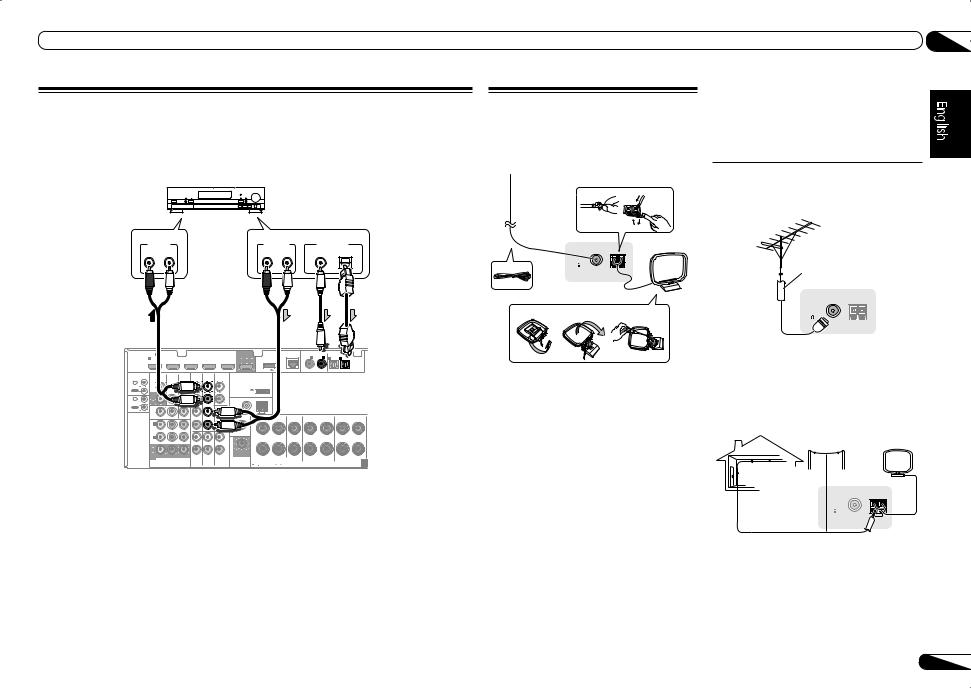
Connecting other audio components
This receiver has both digital and analog inputs, allowing you to connect audio components for playback.
When you set up the receiver you’ll need to tell the receiver which input you connected the component to (see also The Input Setup menu on page 25 ).
CD-R, MD, DAT, etc.
AUDIO IN |
AUDIO OUT |
Select one |
|
|
DIGITAL OUT |
||
R ANALOG L |
R ANALOG |
L |
COAXIAL OPTICAL |
HDMI |
IN 1 |
VIDEO 1 IN |
BD IN |
DVD IN |
DVR/BDR IN |
OUT |
|
LAN(10/100) COAXIAL |
|
|
|
ASSIGNABLE 1 |
|
|
|
|
|
|
DC OUTPUT |
IN 1 |
IN 2 |
1 |
2 |
forWIRELESS LAN |
|
|
|
ASSIGNABLE |
|
|
|
|
|
|
|
(OUTPUT 5V |
0.6 A MAX) |
(DVD) |
(CD) |
(TV/SAT) |
(DVR/BDR) |
CONTROL VIDEO |
AUDIO |
ZONE 2 |
DVR/BDR CD-R/TAPE ZONE 2 |
IN |
|
|
ADAPTER PORT |
|
OUT |
L |
|
OUT |
|
OUT |
(OUTPUT 5 V |
|
MONITOR |
0.1 A MAX) |
|
IR IN |
OUT |
R ANTENNA |
|
|
|||
OUT |
DVR/ |
|
|
|
BDR |
|
AM LOOP |
|
|
|
|
|
OUT |
IN |
DVD IN |
IN |
|
A R |
FRONT |
CENTER |
R |
SURROUND |
SURROUND BACK / ZONE 2 |
|
|
|
|
L |
L |
R |
L(Single) |
||||||
IN 1 |
|
|
|
|
|
|
|
|
|
|
|
|
(DVD) |
|
|
|
|
|
|
|
|
|
|
|
|
ASSIGN |
|
|
|
|
|
|
|
|
|
|
|
|
ABLE |
|
|
|
|
|
|
|
|
|
|
|
|
IN 2 |
|
|
|
|
L |
|
|
|
|
|
|
|
(DVR/ |
|
|
|
|
|
|
|
|
|
|
|
|
BDR) |
|
|
|
IN |
IN |
|
|
|
|
|
|
|
|
|
|
|
|
R |
|
|
|
|
|
|
|
MONITOR |
|
|
|
SUBWOOFER |
|
|
|
|
|
|
|
|
OUT |
Y |
PB |
PR |
TV/SAT VIDEO 1 DVD |
|
CAUTION: |
ATTENTION: |
|
|
|
|
|
|
|
|
|
|
SELE |
|||||||
COMPONENT VIDEO |
|
PRE OUT |
SPEAKER IMPEDANCE ENCEINTE D’IMPEDANCE DE |
|
SPEAKERS |
Class 2Wiring SELE |
||||||
|
6 -16 . |
6 |
-16 . |
|
||||||||
!If you’re connecting a recorder, connect the analog audio outputs to the analog audio inputs on the recorder.
!If your turntable has line-level outputs (i.e., it has a built-in phono pre-amp), connect it to the CD inputs instead.
Connecting AM/FM antennas
Connect the AM loop antenna and the FM wire antenna as shown below. To improve reception and sound quality, connect external antennas (see Connecting external antennas on page 19 ).
1 |
2 |
3
5
FMUNBAL 75
AMLOOP
4
fig. a |
fig. b |
fig. c |
1Pull off the protective shields of both AM antenna wires.
2Push open the tabs, then insert one wire fully into each terminal, then release the tabs to secure the AM antenna wires.
3Fix the AM loop antenna to the attached stand.
To fix the stand to the antenna, bend in the direction indicated by the arrow (fig. a) then clip the loop onto the stand (fig. b).
!If you plan to mount the AM antenna to a wall or other surface, secure the stand with screws (fig. c) before clipping the loop to the stand. Make sure the reception is clear.
4Place the AM antenna on a flat surface and in a direction giving the best reception.
Connecting your equipment |
03 |
5 Connect the FM wire antenna into the FM antenna socket.
For best results, extend the FM antenna fully and fix to a wall or door frame. Don’t drape loosely or leave coiled up.
Connecting external antennas
To improve FM reception, connect an external FM antenna to FM UNBAL 75 W.
75 coaxial cable
ANTENNA
FMUNBAL 75
AMLOOP
To improve AM reception, connect a 5 m to 6 m (16 ft. to 20 ft.) length of vinyl-coated wire to the AM LOOP terminals without disconnecting the supplied AM loop antenna.
For the best possible reception, suspend horizontally outdoors.
Outdoor antenna |
||
Indoor antenna |
|
|
(vinyl-coated wire) |
|
|
|
ANTENNA |
|
|
FMUNBAL |
|
5 m to 6 m |
75 |
|
AMLOOP |
||
|
||
(16 ft. to 20 ft.) |
|
|
En 19
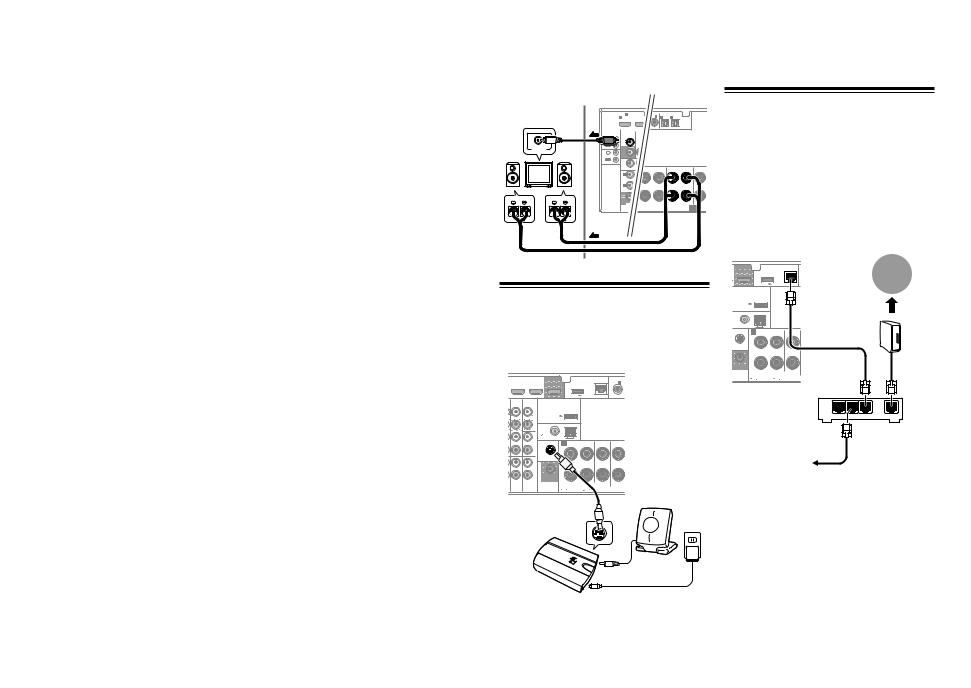
03 Connecting your equipment
MULTI-ZONE setup
This receiver can power up to two independent systems in separate rooms after you have made the proper MULTI-ZONE connections.
Different sources can be playing in two zones at the same time or, depending on your needs, the same source can also be used. The main and sub zone have independent power (the main zone power can be off while sub zone is on) and the sub zone can be controlled by the remote or front panel controls.
Making MULTI-ZONE connections
It is possible to make these connections if you have a separate TV and speakers for the sub zone (ZONE 2). You will also need a separate amplifier if you are not using the MULTI-ZONE setup using speaker terminals (ZONE 2) on page 20 for the sub zone.
MULTI-ZONE listening options
The following table shows the signals that can be output to ZONE 2:
Sub Zone Input functions available
DVD, TV/SAT, DVR/BDR, VIDEO 1,
VIDEO 2, HOME MEDIA GALLERY,
ZONE 2 iPod/USB, CD, CD-R/TAPE, TUNER,
ADAPTER PORT, SIRIUS
(Outputs analog audio, composite video.)
It is not possible to down-convert the audio and video input signals from the HDMI input terminals, digital input terminals (OPTICAL and
COAXIAL) and the COMPONENT VIDEO input terminals and output them to ZONE 2.
20 En
Basic MULTI-ZONE setup (ZONE 2)
% Connect a separate amplifier to the AUDIO ZONE 2 OUT jacks and a TV
monitor to the VIDEO ZONE 2 OUT jack, both on this receiver.
You should have a pair of speakers attached to the sub zone amplifier as shown in the following illustration.
Sub zone (ZONE 2) |
Main zone |
|
HDMI IN 1 VIDEO 1 IN BD IN DVD IN DVR/BDR I |
|
ASSIGNABLE 1 |
|
VIDEO IN |
VIDEO |
|
|
AUDIO |
ZONE 2 |
|
|
|
|
ZONE 2 |
|
|
DVR/BDR CD-R/TAPE |
|
||
|
|
OUT |
|
TV/SAT |
VIDEO |
|
L |
|
|
OUT |
MONITOR |
|
IN |
IN |
|
OUT |
|
|
|
|
|
|
||||
|
IR IN |
OUT |
|
|
|
|
R A |
|
|
|
|
|
|
|
|||
|
OUT |
DVR/ |
|
|
|
|
CD |
FM |
|
|
BDR |
|
|
|
|
L |
75 |
|
|
OUT |
IN |
DVD IN |
IN |
IN |
SI |
|
|
|
IN 1 |
|
|
|
|
R |
|
|
|
(DVD) |
|
|
|
|
|
|
|
|
ASSIGN |
|
|
|
|
|
|
|
|
ABLE |
|
|
|
|
|
|
|
|
IN 2 |
|
|
|
|
L |
|
|
|
(DVR/ |
|
|
|
|
|
|
|
|
BDR) |
|
|
|
IN |
IN |
|
|
AUDIO IN |
|
|
|
|
|
R |
|
|
MONITOR |
|
|
|
|
|
|
|
R |
L |
OUT |
Y |
PB |
PR |
TV/SAT VIDEO 1 |
DVD |
|
|
|
|||||||
|
|
COMPONENT VIDEO |
|
|
|
|||
MULTI-ZONE setup using speaker terminals (ZONE 2)
You must select ZONE 2 in Speaker system setting on page 64 to use this setup.
% Connect a TV monitor to the VIDEO
ZONE 2 OUT jack on this receiver.
You should have a pair of speakers attached to the surround back speaker terminals as shown below.
Sub zone (ZONE 2) |
Main zone |
VIDEO IN
L R
HDMI |
IN 1 |
VIDEOCOAXIAL1 IN |
ASSIGNABLE |
IN |
IN |
|
ASSIGNABLE 1 |
|
IN 1 |
IN 2 |
1 |
2 |
OPTICAL |
|
|
|
|
|
|
|
|
|
|
|
|
|
|
ASSIGNABLE |
|
|
|
|
|
|
|
(DVD) |
(CD) |
(TV/SAT) (DVR/BDR) |
|
|
|
CONTROL |
VIDEO |
|
|
|
|
|
|
|
||
|
|
ZONE 2 |
|
|
|
|
|
|
|
|
|
|
OUT |
|
TV/SAT |
|
|
|
|
|
|
|
|
|
|
|
|
|
|
|
||
|
|
MONITOR |
|
IN |
|
|
|
|
|
|
IR |
IN |
OUT |
|
|
|
|
|
|
|
|
|
|
|
|
|
|
|
|
|
||
|
OUT |
DVR/ |
|
|
|
|
|
|
|
|
|
|
BDR |
|
|
|
|
|
|
|
|
|
|
OUT |
IN |
SURROUND |
SURROUND BACK / ZONE2 |
FRONT HEIG |
||||
|
|
|
|
|
R |
L |
R |
L(Single) |
R |
|
|
|
IN 1 |
|
|
|
|
|
|
|
|
|
|
(DVD) |
|
|
|
|
|
|
|
|
|
|
ASSIGN |
|
|
|
|
|
|
|
|
|
|
ABLE |
|
|
|
|
|
|
|
|
|
|
IN 2 |
|
|
|
|
|
|
|
|
|
|
(DVR/ |
|
|
|
|
|
|
|
|
|
|
BDR) |
|
|
|
|
|
|
|
|
|
|
MONITOR |
|
|
|
|
|
|
|
|
|
|
OUT |
Y |
PB |
|
|
|
|
SELECTABLE SEE INS |
|
|
|
COMPONENT VI |
SPEAKERS |
|
||||||
|
|
Class 2Wiring |
SELECTABLE VOIR LE |
|||||||
Connecting to the network through LAN interface
By connecting this receiver to the network via the LAN terminal, you can listen to Internet radio stations. To listen to Internet radio stations, you must sign a contract with an ISP (Internet Service Provider) beforehand.
When connected in this way, you can play audio files stored on the components on the network, including your computer, using HOME MEDIA GALLERY inputs.
Connecting a SiriusConnect Tuner
To receive SIRIUS Satellite Radio broadcasts, you will need to activate your SiriusConnectTM tuner.
DVD IN |
DVR/BDR IN |
OUT |
LAN(10/100) COAXIAL A |
|
|
DC OUTPUT |
IN 1 |
forWIRELESS LAN
|
|
|
|
|
(OUTPUT 5V |
0.6 A MAX) |
|
(DVD) |
R CD-R/TAPE |
ZONE 2 |
|
|
|
|
|
|
|
|
L |
|
ADAPTER PORT |
|
|
|
||
|
OUT |
|
(OUTPUT 5 V |
|
|
|
|
|
|
|
0.1 A MAX) |
|
|
|
|
|
|
|
R ANTENNA |
|
|
|
|
|
||
|
CD |
FM UNBAL |
|
|
|
|
|
|
|
L |
75 |
AM LOOP |
|
|
|
|
|
|
IN |
SIRIUS |
A |
R FRONT L |
CENTER |
RSUR |
||
|
R |
|
|
|
|
|
|
|
|
L |
|
|
|
|
|
|
|
|
IN |
|
|
|
|
|
|
|
|
R |
|
SUBWOOFER |
|
|
|
|
|
|
|
|
|
|
|
|
|
|
T VIDEO 1 |
DVD |
|
|
CAUTION: |
ATTENTION: |
|
||
|
|
|
PRE OUT |
SPEAKER IMPEDANCE ENCEINTE D’IMPEDANCE DE |
|
|||
|
|
|
6 -16 . |
6 -16 . |
|
|
||
SiriusConnectTM
HOME tuner
SIRIUS |
H |
Antenna
SIRIUS
AC adapter
You will also need to connect the antenna and AC adapter to the SiriusConnectTM tuner.
!For instructions on playing the SIRIUS Radio, see Listening to Satellite Radio on page 31 .
OUT |
LAN(10/100) C |
DC OUTPUT forWIRELESS LAN
(OUTPUT 5V |
0.6 A MAX) |
(OUTPUT 5 V |
|
|
Internet |
ADAPTER PORT |
|
||
0.1 A MAX) |
|
|
|
TENNA |
|
|
|
UNBAL |
|
|
Modem |
AM LOOP |
|
||
IUS |
A |
R FRONT L |
CENTER |
IN |
|
|
|
SUBWOOFER
CAUTION: ATTENTION:
PRE OUT |
SPEAKER IMPEDANCE |
ENCEINTE D’IMPEDANCE DE |
6 -16 . |
6 -16 . |
LAN
3 |
2 |
1 |
WAN |
Router
LAN cable (sold separately)
to LAN port
PC
Connect the LAN terminal on this receiver to the LAN terminal on your router (with or without the built-in DHCP server function) with a straight LAN cable (CAT 5 or higher).
Turn on the DHCP server function of your router. In case your router does not have the built-in DHCP server function, it is necessary to set up the network manually. For details, see
Network Setup menu on page 66 .
LAN terminal specifications
!LAN terminal : Ethernet jack (10BASE-T/100BASE-TX)
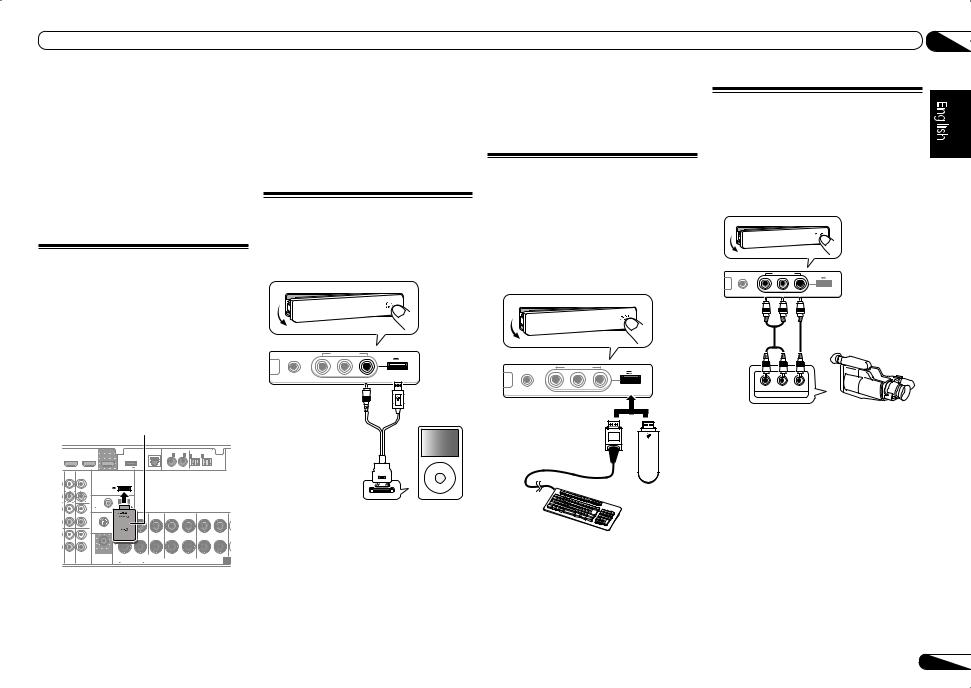
 Note
Note
!Refer to the operation manual of the equipment you have as the
connectedequipment and connection method may differ depending on your Internetenvironment.
!When using a broadband Internet connection, a contract with an Internetservice provider
is required. For more details, contact your nearest Internetservice provider.
Connecting optional Bluetooth ADAPTER
When the Bluetooth® ADAPTER (AS-BT100 or AS-BT200) is connected to this receiver, a product equipped with Bluetooth wireless technology (portable cell phone, digital music player, etc.) can be used to listen to music wirelessly.
!The Bluetooth wireless technology enabled device must support A2DP profiles.
!Pioneer does not guarantee proper connection and operation of this unit with all Bluetooth wireless technology enabled devices.
Bluetooth® ADAPTER
DVD IN |
DVR/BDR IN |
OUT |
LAN(10/100) COAXIAL ASSIGNABLE |
IN |
IN |
|
||
|
|
DC OUTPUT |
IN 1 |
IN 2 |
1 |
2 |
OPTICAL |
|
|
|
forWIRELESS LAN |
|
|
|
|
||
|
|
|
|
|
|
|
|
ASSIGNABLE |
|
|
(OUTPUT 5V |
0.6 A MAX) |
(DVD) |
(CD) |
(TV/SAT) (DVR/BDR) |
||
R CD-R/TAPE ZONE 2 |
|
|
|
|
|
|
|
|
L |
|
ADAPTER PORT |
|
|
|
|
|
|
OUT |
|
(OUTPUT 5 V |
|
|
|
|
|
|
|
0.1 A MAX) |
|
|
|
|
|
|
|
R ANTENNA |
|
|
|
|
|
|
||
CD |
FM UNBAL |
|
|
|
|
|
|
|
L |
75 |
AM |
|
|
|
|
|
|
IN |
SIRIUS |
|
CENTER |
R |
SURROUND |
SURROUND BACK / ZONE 2 F |
||
|
|
|
|
L |
L |
R |
L(Single) |
|
R |
|
|
|
|
|
|
|
|
|
|
IN |
|
|
|
|
|
|
L |
|
|
|
|
|
|
|
|
IN |
|
|
|
|
|
|
|
|
R |
|
SUBWOOFER |
|
|
|
|
|
|
|
|
|
|
|
|
|
|
|
T VIDEO 1 DVD |
|
|
CAUTION: |
ATTENTION: |
|
|
|
SELECT |
|
|
PRE OUT |
SPEAKER IMPEDANCE ENCEINTE D’IMPEDANCE DE |
|
SPEAKERS |
Class 2 Wiring SELECT |
||
|
|
6 -16 . |
6 -16 . |
|
||||
 Important
Important
!Do not move the receiver with the Bluetooth ADAPTER connected. Doing so could cause damage or faulty contact.
% Switch the receiver into standby and connect Bluetooth ADAPTER to the ADAPTER PORT.
!For instructions on playing the Bluetooth wireless technology device, see Pairing the Bluetooth ADAPTER and Bluetooth wireless technology device on page 33 .
Connecting an iPod
This receiver has a dedicated iPod terminal that will allow you to control playback of audio content from your iPod using the controls of this receiver.
|
VIDEO 2 INPUT |
|
|
|
|
5V |
2.1 A |
|
|
iPod |
USB |
MCACC |
|
iPhone |
|
SETUP MIC |
L AUDIO R |
VIDEO iPad |
|
iPod cable (supplied)
MENU
iPod
% Switch the receiver into standby then use the supplied iPod cable to connect your iPod to the iPod iPhone iPad USB terminal on the front panel of this receiver.
!It is also possible to connect using the cable included with the iPod, but in this case it is not possible to view pictures via the receiver.
!For the cable connection, also refer to the operating instructions for your iPod.
!For instructions on playing the iPod, see
Playing an iPod on page 28 .
Connecting a USB device
It is possible to play audio and photo files by connecting USB devices to this receiver. It is also possible to connect a USB keyboard
(US-international layout) to the receiver to enter text in the following GUI screens.
!Change the input name in the Input Setup menu (page 25).
!Add names to radio station presets (page 31).
|
|
VIDEO 2 INPUT |
|
|
|
|
|
|
|
5V |
2.1 A |
|
|
|
|
iPod |
USB |
MCACC |
|
|
|
iPhone |
|
SETUP MIC |
L |
AUDIO R |
VIDEO |
iPad |
|
USB mass storage device
USB keyboard
% Switch the receiver into standby then connect your USB device to the USB terminal on the front panel of this receiver.
!This receiver does not support a USB hub.
!For instructions on playing the USB device, see Playing a USB device on page 29 .
Connecting your equipment |
03 |
Connecting to the front panel video terminal
Front VIDEO 2 connections are accessed via the front panel using the INPUT SELECTOR or INPUT SELECT c/d button on the remote control. There are standard audio/video jacks.
Hook them up the same way you made the rear panel connections.
|
VIDEO 2 INPUT |
|
|
|
|
5V |
2.1 A |
|
|
iPod |
USB |
MCACC |
|
iPhone |
|
SETUP MIC |
L AUDIO R |
VIDEO iPad |
|
L |
R |
VIDEO |
AUDIO/VIDEO OUTPUT
Video camera (etc.)
En 21
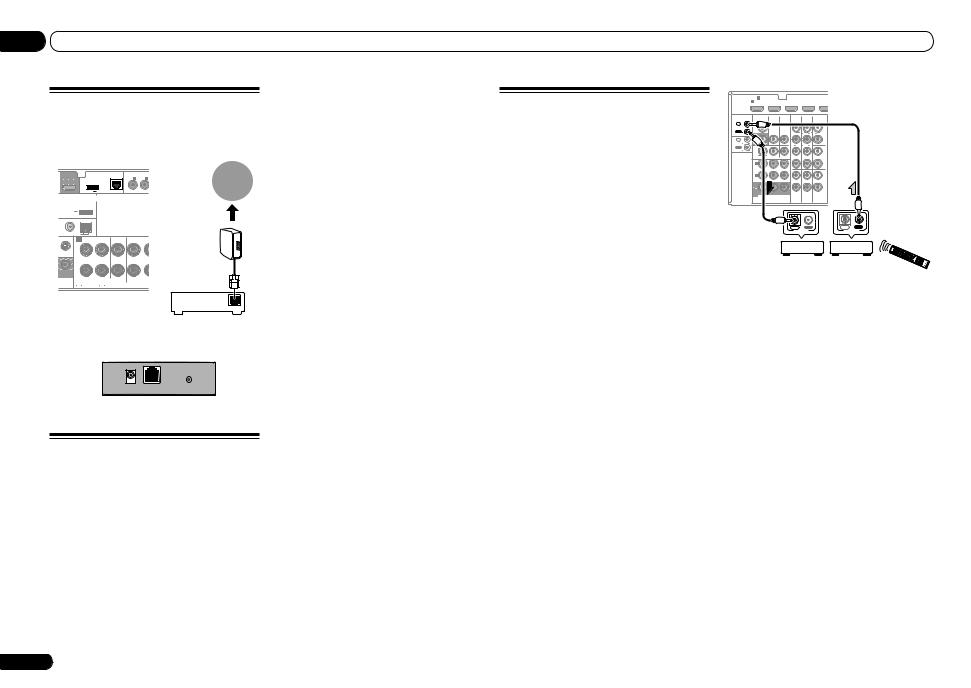
03 Connecting your equipment
Connecting to a wireless LAN
Wireless connection to the network is possible through a wireless LAN connection. Use the separately sold AS-WL300 for connection.
OUT |
|
LAN(10/100) COAXIAL ASSIGNAB |
|
|
DC OUTPUT |
IN 1 |
IN 2 |
|
|
forWIRELESS LAN |
|
|
|
|
(OUTPUT 5V 0.6 A MAX) |
|
(DVD) (CD) |
(OUTPUT 5 V |
|
|
|
Internet |
ADAPTER |
|
|
||
0.1 A MAX) |
|
|
|
|
TENNA |
|
|
|
|
UNBAL |
|
|
|
Modem |
AM LOOP |
|
|
||
IUS |
A |
R FRONT L |
CENTER |
RSURROUN |
IN |
|
|
|
|
SUBWOOFER |
|
|
|
|
|
CAUTION: |
ATTENTION: |
|
Router |
PRE OUT |
SPEAKER IMPEDANCE ENCEINTE D’IMPEDANCE DE |
SPE |
||
6 -16 . |
6 -16 . |
|
||
WAN
DC 5V Ethernet |
WPS |
Wireless LAN convereter (AS-WL300)
!If using two remote controls (at the same time), the IR receiver’s remote sensor takes priority over the remote sensor on the front panel.
1 Connect the IR receiver sensor to the IR IN jack on the rear of this receiver.
Closet or shelving unit |
|
|
|
Pioneer |
Non-Pioneer |
||
component |
component |
||
CONTROL |
|
IR |
|
IN |
OUT |
|
IN |
HDMI IN 1 |
VIDEO 1 IN BD IN DVD IN DVR/BDR IN |
OUT |
LAN |
ASSIGNABLE 1 |
|
|
DC OUTPUT |
forWIRELESS LAN
(OUTPUT 5V |
0.6 A MAX) |
CONTROL |
VIDEO |
|
|
AUDIO |
|
|
|
|
|
|
|
|
IN |
ZONE 2 |
|
|
DVR/BDR CD-R/TAPE |
ZONE 2 |
|
|
|
|
|
|
|
|
|
|
|
|
|
|
ADAPTER PORT |
|
|
|||
|
OUT |
|
TV/SAT |
VIDEO 1 |
|
L |
|
|
|
|||
OUT |
|
|
|
|
(OUTPUT 5 V |
|
|
|
|
|||
|
MONITOR |
|
IN |
IN |
OUT |
OUT |
0.1 A MAX) |
|
|
|
|
|
IR IN |
OUT |
|
|
|
|
R ANTENNA |
|
|
|
|
||
|
|
|
|
|
|
|
|
|
||||
OUT |
DVR/ |
|
|
|
|
CD |
FM UNBAL |
|
|
|
|
|
|
BDR |
|
|
|
|
L |
75 |
AM LOOP |
|
|
|
|
|
OUT |
IN |
DVD IN |
IN |
IN |
SIRIUS |
A |
R |
FRONT |
L |
C |
|
|
IN 1 |
|
|
|
|
R |
|
|
|
|
|
|
|
(DVD) |
|
|
|
|
|
|
|
|
|
|
|
|
ASSIGN |
|
|
|
|
|
IN |
|
|
|
|
|
|
ABLE |
|
|
|
|
|
|
|
|
|
|
|
|
IN 2 |
|
|
|
|
L |
|
|
|
|
|
|
|
(DVR/ |
|
|
|
|
|
|
|
|
|
|
|
|
BDR) |
|
|
|
IN |
IN |
|
|
|
|
|
|
|
|
|
|
|
|
R |
SUBWOOFER |
|
|
|
|
|
|
MONITOR |
|
|
|
|
|
|
|
|
|
||
|
OUT |
Y |
PB |
PR |
TV/SAT VIDEO 1 |
DVD |
|
CAUTION: |
ATTENTION |
|||
COMPONENT VIDEO |
PRE OUT |
SPEAKER IMPEDANCE ENCEINTE D’IMPE |
|
6 -16 . |
6 -16 . |
||
IR receiver
Connecting an IR receiver
If you keep your stereo components in a closed cabinet or shelving unit, or you wish to use the sub zone remote control in another zone, you can use an optional IR receiver (such as a Niles or Xantech unit) to control your system instead of the remote sensor on the front panel of this receiver.
!Remote operation may not be possible if direct light from a strong fluorescent lamp is shining on the IR receiver remote sensor window.
!Note that other manufacturers may not use the IR terminology. Refer to the manual that came with your component to check for IR compatibility.
2 Connect the IR IN jack of another component to the IR OUT jack on the rear of this receiver to link it to the IR receiver.
Please see the manual supplied with your IR receiver for the type of cable necessary for the connection.
!If you want to link a Pioneer component to the IR receiver, see Operating other Pioneer components with this unit’s sensor on page 22 to connect to the CONTROL jacks instead of the IR OUT jack.
Operating other Pioneer components with this unit’s sensor
Many Pioneer components have SR CONTROL jacks which can be used to link components together so that you can use just the remote sensor of one component. When you use a remote control, the control signal is passed along the chain to the appropriate component.
!If you want to control all your components using this receiver’s remote control, see page 52.
!If you have connected a remote control to the CONTROL IN jack (using a mini-plug cable), you won’t be able to control this unit using the remote sensor.
 Important
Important
!Note that if you use this feature, make sure that you also have at least one set of analog audio, video or HDMI jacks connected to another component for grounding purposes.
1Decide which component you want to use the remote sensor of.
When you want to control any component in the chain, this is the remote sensor at which you’ll point the corresponding remote control.
2Connect the CONTROL OUT jack of that component to the CONTROL IN jack of another Pioneer component.
Use a cable with a mono mini-plug on each end for the connection.
HDMI |
IN 1 VIDEO 1 IN |
BD IN |
DVD IN DVR/BD |
ASSIGNABLE 1
CONTROL |
VIDEO |
|
|
AUDIO |
|
|
|
||
|
IN |
ZONE 2 |
|
|
DVR/BDR CD-R/TAPE |
ZONE 2 |
|
||
|
|
|
|
|
|
|
|
|
|
|
|
OUT |
|
TV/SAT |
VIDEO 1 |
|
|
L |
|
|
OUT |
|
|
|
|
|
|
||
|
MONITOR |
|
IN |
IN |
OUT |
|
OUT |
|
|
|
|
|
|
|
|||||
IR |
IN |
OUT |
|
|
|
|
|
R |
|
|
|
|
|
|
|
|
|||
|
OUT |
DVR/ |
|
|
|
|
|
CD |
|
|
|
BDR |
|
|
|
|
|
L |
|
|
|
OUT |
IN |
DVD IN |
IN |
|
IN |
|
|
|
|
IN 1 |
|
|
|
|
|
R |
|
|
|
(DVD) |
|
|
|
|
|
|
|
|
|
ASSIGN |
|
|
|
|
|
|
|
|
|
ABLE |
|
|
|
|
|
|
|
|
|
IN 2 |
|
|
|
|
|
L |
|
|
|
(DVR/ |
|
|
|
|
|
|
|
|
|
BDR) |
|
|
|
IN |
|
IN |
|
|
|
|
|
|
|
|
|
R |
|
|
|
MONITOR |
|
|
|
|
|
|
|
|
|
OUT |
Y |
PB |
PR |
TV/SAT VIDEO 1 |
DVD |
|
|
|
|
COMPONENT VIDEO |
|
|
|
|
|||
|
|
|
|
|
|
IN |
OUT |
IN |
OUT |
|
|
|
|
|
|
CONTROL |
CONTROL |
||
3 Continue the chain in the same way for as many components as you have.
22 En

Connecting your equipment |
03 |
Plugging in the receiver
Only plug in after you have connected all your components to this receiver, including the speakers.
 CAUTION
CAUTION
!Handle the power cord by the plug part. Do not pull out the plug by tugging the cord, and never touch the power cord when your hands are wet, as this could cause a short circuit or electric shock. Do not place the unit, a piece of furniture, or other object on the power cord or pinch the cord in any other way. Never make a knot in the cord or tie it with other cables. The power cords should be routed so that they are not likely to be stepped on. A damaged power cord can cause a fire or give you an electric shock. Check the power cord once in a while. If you find it damaged, ask your nearest Pioneer authorized independent service company for a replacement.
!The receiver should be disconnected by removing the mains plug from the wall socket when not in regular use, e.g., when on vacation.
% Plug the AC power cord into a convenient AC power outlet.
!After this receiver is connected to an AC outlet, a 2 second to 10 second HDMI initialization process begins. You cannot carry out any operations during this process. The HDMI indicator in the front panel display blinks during this process, and you can turn on this receiver once it has stopped blinking. When you set the Control with HDMI to OFF, you can skip this process. For details about the Control with HDMI feature, see Control with HDMI function on page 43 .
En 23
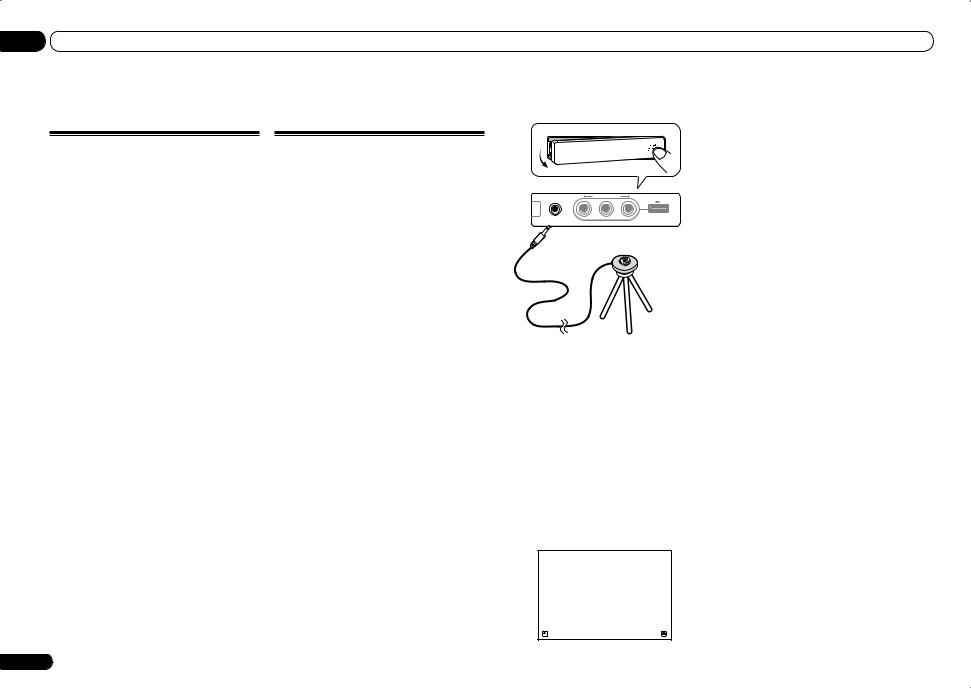
04 Basic Setup
Basic Setup
Changing the OSD display language (OSD Language)
The language used on the Graphical User Interface screen can be changed.
!The explanations in these operating instructions are for when English is selected for the GUI screen.
1Press uRECEIVER to switch on the receiver and your TV.
Make sure that the TV’s video input is set to this receiver (for example, if you connected this receiver to the VIDEO jacks on your TV, make sure that the VIDEO input is now selected).
2Press 



 on the remote control, then press HOME MENU.
on the remote control, then press HOME MENU.
A Graphical User Interface (GUI) screen appears on your TV. Use i/j/k/l and ENTER to navigate through the screens and select menu items. Press RETURN to exit the current menu.
3Select ‘System Setup’ from the Home Menu.
4Select ‘OSD Language’ from the System Setup menu.
5Select the desired language.
6Select ‘OK’ to change the language.
The setting is completed and the System Setup menu reappears automatically.
Automatically conducting optimum sound tuning (Full Auto MCACC)
The Full Auto MCACC Setup measures the acoustic characteristics of your listening area, taking into account ambient noise, speaker connection and speaker size, and tests for both channel delay and channel level. After you have set up the microphone provided with your system, the receiver uses the information from a series of test tones to optimize the speaker settings and equalization for your particular room.
 Important
Important
!Make sure the microphone and speakers are not moved during the Full Auto MCACC Setup.
!Using the Full Auto MCACC Setup will overwrite any existing settings for the MCACC preset you select.
!Before using the Full Auto MCACC Setup, the headphones should be disconnected.
 CAUTION
CAUTION
!The test tones used in the Full Auto MCACC Setup are output at high volume.
THX®
!THX is a trademark of THX Ltd., which may be registered in some jurisdictions. All rights reserved.
1 Press uRECEIVER to switch on the receiver and your TV.
Make sure that the TV’s video input is set to this receiver.
2 Connect the microphone to the MCACC SETUP MIC jack on the front panel.
|
VIDEO 2 INPUT |
|
|
|
|
5V |
2.1 A |
|
|
iPod |
USB |
MCACC |
|
iPhone |
|
SETUP MIC |
L AUDIO R |
VIDEO iPad |
|
Microphone
Tripod
Make sure there are no obstacles between the speakers and the microphone.
If you have a tripod, use it to place the microphone so that it’s about ear level at your normal listening position. If you do not have a tripod, use some other object to install the microphone.
Install the microphone on a stable floor. Placing the microphone on any of the following surfaces may make accurate measurement impossible:
!Sofas or other soft surfaces.
!High places such as tabletops and sofa tops. The Full Auto MCACC display appears once the microphone is connected.
1a.Full Auto MCACC
A/V RECEIVER
Speaker System |
: Normal(SB/FH) |
||
EQ Type |
: |
SYMMETRY |
|
MCACC |
: M1.MEMORY 1 |
||
THX Speaker |
: |
NO |
|
|
|
|
|
|
|
START |
|
Exit |
|
|
Return |
!If you leave the GUI screen for over five minutes, the screen saver will appear.
3Select the parameters you want to set.
!When data measurement is taken, the reverb characteristics data (both beforeand after-calibration) that this receiver had been storing will be overwritten.
!When measurement is taken of the reverb characteristics data other than SYMMETRY, the data are not measured after the correction. If you will need to measure after
correcting data, take the measurement using the EQ Professional menu in the Manual MCACC setup (page 60).
If the speakers are connected using any setup other than Normal(SB/FH), be sure to set Speaker System before the Full Auto MCACC Setup. See Speaker system setting on page 64 .
!Speaker System – Shows the current settings. When this is selected and ENTER is pressed, the speaker system selection screen appears. Select the proper speaker system, then press RETURN to return.
If you are planning on bi-amping your front speakers, or setting up a separate speaker system in another room, read through
Speaker system setting on page 64 and make sure to connect your speakers as necessary before continuing to step 4.
!EQ Type – This determines how the frequency balance is adjusted.
!MCACC – The six MCACC presets are used for storing surround sound settings for different listening positions. Simply choose an unused preset for now (you can rename it later in Data Management on page 63 ).
!THX Speaker – Select YES when using THX speakers (all speakers other than the front speakers are set to SMALL). In other cases, leave at NO.
4 Press  then select START.
then select START.
24 En
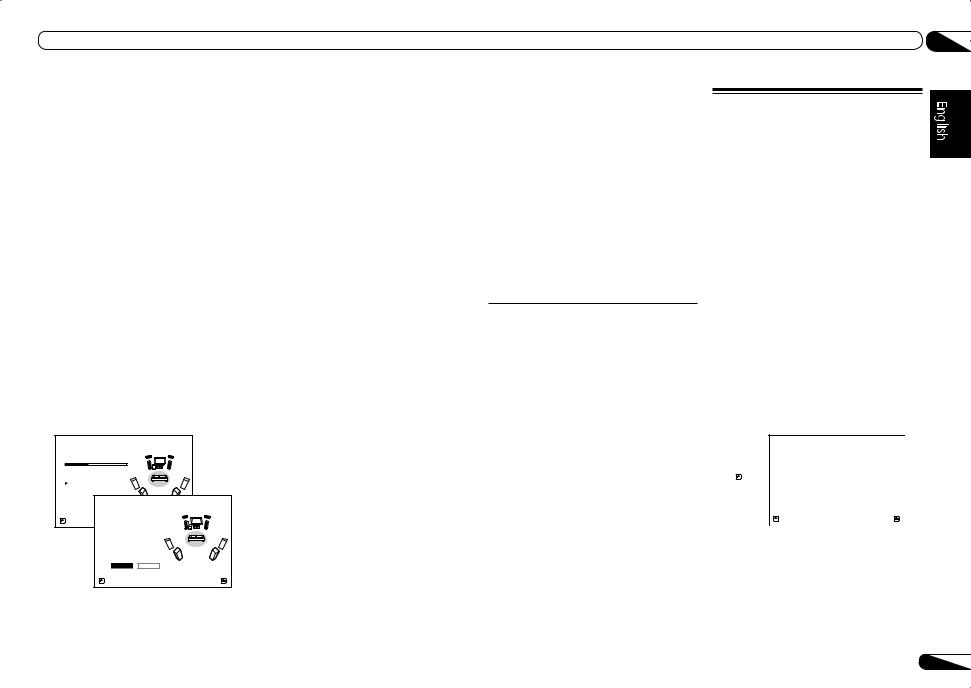
5Follow the instructions on-screen.
Make sure the microphone is connected, and if you’re using a subwoofer, make sure it is switched on and set to a comfortable volume level.
6Wait for the test tones to finish, then confirm the speaker configuration in the GUI screen.
A progress report is displayed on-screen while the receiver outputs test tones to determine the speakers present in your setup. Try to be as quiet as possible while it’s doing this.
If no operations are performed for 10 seconds while the speaker configuration check screen is being displayed, the Full Auto MCACC Setup will resume automatically. In this case, you don’t need to select ‘OK’ and press ENTER in step 7.
!With error messages (such as Too much ambient noise! or Check microphone.), select RETRY after checking for ambient noise (see Problems when using the Auto MCACC Setup on page 25 ) and verifying the mic connection. If there doesn’t seem to be a problem, you can simply select GO NEXT and continue.
1a.Full Auto MCACC |
|
||||
|
A/V RECEIVER |
|
|||
Now Analyzing... |
|
|
2/9 |
|
|
Environment Check |
|
|
|
|
|
Ambient Noise |
|
: OK |
|
|
|
Microphone |
|
: |
|
|
|
Speaker YES/NO |
: |
|
|
|
|
|
|
|
|
1a.Full Auto MCACC |
|
|
L |
|
: |
A/V RECEIVER |
|
|
|
YES |
|
||
Exit |
FHL |
: |
YES |
Cancel |
|
C |
|
: |
YES |
||
|
FHR |
: |
YES |
|
|
|
R |
|
: |
YES |
|
|
SR |
|
: |
YES |
|
|
SBR |
: |
YES |
|
|
|
SBL |
: |
YES |
|
|
|
SL |
|
: |
YES |
|
10SW |
|
: |
YES |
|
|
|
|
|
OK |
RETRY |
|
|
Exit |
|
|
Cancel |
|
The configuration shown on-screen should reflect the actual speakers you have.
!If you see an ERR message (or the speaker configuration displayed isn’t correct),
there may be a problem with the speaker connection. If selecting RETRY doesn’t work, turn off the power and check the speaker connections. If there doesn’t seem to be a problem, you can simply use i/jto select the speaker and k/lto change the setting and continue.
!If the speaker is not pointed to the microphone (listening position) or when using speakers that affect the phase (dipole speakers, reflective speakers, etc.), Reverse Phase may be displayed even if the speakers are properly connected.
If Reverse Phase is displayed, the speaker’s wiring (+ and –) may be inverted. Check the speaker connections.
—If the connections were wrong, turn off the power, disconnect the power cord, then reconnect properly. After this, perform the Full Auto MCACC procedure again.
—If the connections were right, select GO NEXT and continue.
7Make sure ‘OK’ is selected, then press ENTER.
A progress report is displayed on-screen while the receiver outputs more test tones to determine the optimum receiver settings.
Again, try to be as quiet as possible while this is happening. It may take 3 to 10 minutes.
8The Full Auto MCACC Setup procedure is completed and the Home Menu menu reappears automatically.
Be sure to disconnect the microphone from this receiver upon completion of the Full Auto MCACC Setup.
The settings made in the Full Auto MCACC Setup should give you excellent surround sound from your system, but it is also possible to adjust these settings manually using The Advanced MCACC menu on page 58 or The System Setup and Other Setup menus on page
64.
!Depending on the characteristics of your room, sometimes identical speakers with cone sizes of around 12 cm (5 inches) will end up with different size settings. You can correct the setting manually using the
Manual speaker setup on page 64 .
!The subwoofer distance setting may be farther than the actual distance from the listening position. This setting should be accurate (taking delay and room
characteristics into account) and generally does not need to be changed.
!If Full Auto MCACC Setup measurement results are incorrect due to the interaction of the speakers and viewing environment, we recommend adjusting the settings manually.
Problems when using the Auto MCACC Setup
If the room environment is not optimal for the Auto MCACC Setup (too much background noise, echo off the walls, obstacles blocking the speakers from the microphone) the final settings may be incorrect. Check for household appliances (air conditioner, fridge, fan, etc.), that may be affecting the environment and switch them off if necessary. If there are any instructions showing in the front panel display, please follow them.
!Some older TVs may interfere with the operation of the microphone. If this seems to be happening, switch off the TV when doing the Auto MCACC Setup.
Basic Setup |
04 |
The Input Setup menu
You only need to make settings in the
Input Setup menu if you didn’t hook up your digital equipment according to the default settings (see Input function default and possible settings on page 26 ). In this case, you need to tell the receiver what equipment is hooked up to which terminal so the buttons on the remote control correspond to the components you’ve connected.
1 Press


 on the remote control, then press HOME MENU.
on the remote control, then press HOME MENU.
A Graphical User Interface (GUI) screen appears on your TV. Use i/j/k/l and ENTER to navigate through the screens and select menu items. Press RETURN to exit the current menu.
2Select ‘System Setup’ from the Home Menu.
3Select ‘Input Setup’ from the System Setup menu.
|
|
|
|
4.System Setup |
|
||||
|
|
|
|
A/V RECEIVER |
|
|
|
||
|
a.Manual SP Setup |
|
|
|
|
||||
|
b. Input Setup |
|
|
|
|
|
|
||
|
c. OSD Language |
|
|
|
|
|
|||
|
d. Network Setup |
|
|
|
|
||||
|
e. HDMI Setup |
|
|
|
|
|
|
||
|
f. Other Setup |
|
|
4b.Input Setup |
|||||
|
|
|
|
|
|
|
A/V RECEIVER |
||
|
|
|
|
|
|
|
|
||
|
|
|
|
Input |
: |
DVD |
|||
|
|
|
|
Input Name |
: |
Rename |
|
||
|
|
|
|
Input Skip |
: |
OFF |
|||
|
Exit |
Digital In |
: |
COAX-1 |
|||||
|
HDMI Input |
: |
Return |
||||||
|
|
|
|
DVD |
|||||
|
|
|
|
Component In |
: |
In-1 |
|||
|
|
|
|
Exit |
|
|
|
Finish |
|
|
|
|
|
|
|
|
|
|
|
4 Select the input function that you want to set up.
The default names correspond with the names next to the terminals on the rear panel (such as DVD or VIDEO 1) which, in turn, correspond with the names on the remote control.
En 25

04 Basic Setup
5Select the input(s) to which you’ve connected your component.
For example, if your DVD player only has an optical output, you will need to change the DVD input function’s Digital In setting from COAX-1 (default) to the optical input you’ve connected it to. The numbering (OPT-1 to OPT-2) corresponds with the numbers beside the inputs on the back of the receiver.
6When you’re finished, proceed to the settings for other inputs.
There are optional settings in addition to the assignment of the input jacks:
!Input Name – You can choose to rename the input function for easier identification. Select Rename to do so, or Default to return to the system default.
!Input Skip – When set to ON, that input is skipped when selecting the input using INPUT SELECT. (DVD and other inputs can be still be selected directly with the input function buttons.)
7When you’re finished, press RETURN.
You will return to the System Setup menu.
Input function default and possible settings
The terminals on the receiver generally correspond to the name of one of the input functions. If you have connected components to this receiver differently from (or in addition to) the defaults below, see The Input Setup menu on page 25 to tell the receiver how you’ve connected up. The dots (k) indicate possible assignments.
Input |
Input Terminals |
|||
function |
Digital |
HDMI |
Component |
|
DVD |
COAX-1 |
(DVD) |
IN 1 |
|
BD |
|
(BD) |
|
|
TV/SAT |
OPT-1 |
k |
k |
|
<a> |
||||
|
|
|
||
DVR/BDR |
OPT-2 |
(DVR/ |
IN 2 |
|
BDR) |
||||
|
|
|
||
VIDEO 1 |
|
(VIDEO |
k |
|
|
1) |
|||
|
|
|
||
VIDEO 2 |
|
|
|
|
HDMI 1 |
|
IN 1 |
|
|
HOME |
|
|
|
|
MEDIA |
|
|
|
|
GALLERY |
|
|
|
|
iPod/USB |
|
|
|
|
|
|
|
|
|
CD |
COAX-2 |
|
|
|
CD-R/TAPE |
k |
|
|
|
|
|
|
|
|
TUNER |
|
|
|
|
ADAPTER |
|
|
|
|
PORT |
|
|
|
|
SIRIUS |
k |
|
|
|
aWith Control with HDMI set to ON, assignments cannot be made (see Control with HDMI function on page 43 ).
Operation Mode Setup
This receiver is equipped with a great number of functions and settings. The Operation Mode feature is provided for users who find it difficult to master all these functions and settings.
One of two settings can be selected for the
Operation Mode: Expert and Basic.
1 Press  on the remote control, then press HOME MENU.
on the remote control, then press HOME MENU.
A Graphical User Interface (GUI) screen appears on your TV. Use i/j/k/l and ENTER to navigate through the screens and select menu items. Press RETURN to exit the current menu.
2Select ‘Operation Mode Setup’ from the Home Menu.
3Select the Operation Mode setting you want.
!Expert (default) – Users can set all the functions by themselves.
!Basic – The number of operable functions is restricted, and functions whose operations are restricted are automatically set to achieve the Pioneer-recommended sound and picture quality. The functions that can be operated are shown below. They can be set as necessary by referring to the operating instructions.
Operable |
|
|
|
functions/ |
Descriptions |
Page |
|
items |
|
|
|
HOME MENU |
|
|
|
Full Auto |
Makes high precision |
24 |
|
MCACC |
sound field settings easily. |
||
|
|||
|
Input names can be |
|
|
Input Name |
changed as desired for |
25 |
|
|
easier use. |
|
|
Input Skip |
Inputs not being used are |
25 |
|
skipped (not displayed). |
|||
|
|
Operable |
|
|
|
functions/ |
Descriptions |
Page |
|
items |
|
|
|
Software |
Updates to the latest ver- |
|
|
Update |
sion of the software. |
|
|
Network |
Checks the receiver’s IP |
|
|
Setup |
address. |
|
|
Pairing |
Pairs with a Bluetooth |
|
|
Bluetooth |
device using AS-BT100 or |
33 |
|
Setup |
AS-BT200. |
|
|
Audio Parameters |
|
||
MCACC |
Selects your favorite |
|
|
(MCACC |
46 |
||
MCACC preset memory. |
|||
preset) |
|
||
|
|
||
DELAY |
Adjusts the delay time of |
46 |
|
(Sound Delay) |
the overall sound. |
||
|
|||
S.RTRV |
Plays compressed sound |
|
|
(Auto Sound |
46 |
||
with high sound quality. |
|||
Retriever) |
|
||
|
|
||
DUAL |
Dual monaural audio |
46 |
|
(Dual Mono) |
setting. |
||
|
|||
V.SB |
Creates a virtual surround |
|
|
(Virtual Sur- |
back channel sound for |
46 |
|
round Back) |
playback. |
|
|
V.HEIGHT |
Creates a virtual height |
|
|
(Virtual |
channel sound for play- |
46 |
|
Height) |
back. |
|
|
Other functions |
|
|
|
INPUT |
|
|
|
SELECT |
Switches the input. |
28 |
|
(INPUT |
|||
|
|
||
SELECTOR) |
|
|
|
MASTER |
Use to set the listening |
|
|
VOLUME +/–, |
28 |
||
volume. |
|||
MUTE |
|
|
|
LISTENING |
Only Pioneer-recommended |
35 |
|
MODE |
modes can be selected. |
|
|
PQLS |
Plays using the PQLS |
44 |
|
function. |
|||
|
|
||
PHASE CTRL |
Plays with phase shifting in |
|
|
(Phase Con- |
37 |
||
the low range corrected. |
|||
trol) |
|
||
|
|
||
26 En

Basic Setup |
04 |
Operable |
|
|
|
|
functions/ Descriptions |
Page |
|
||
items |
|
|
|
|
SOUND |
Switches the input to |
|
|
|
ADAPTER PORT and plays |
|
|
|
|
RETRIEVER |
34 |
|
|
|
compressed sound with |
|
|
||
AIR |
|
|
|
|
high sound quality. |
|
|
|
|
|
|
|
|
|
iPod iPhone |
Switches the input to iPod/ |
|
|
|
USB and sets the mode |
|
|
|
|
iPad DIRECT |
29 |
|
|
|
allowing operation from |
|
|
||
CONTROL |
the iPod. |
|
4 When you’re finished, press RETURN.
You will return to the Home Menu.
En 27

05 Basic playback
Basic playback
Playing a source
Here are the basic instructions for playing a source (such as a DVD disc) with your home theater system.
1Switch on your system components and receiver.
Start by switching on the playback component (for example a DVD player), your TV and subwoofer (if you have one), then the receiver (press u RECEIVER).
Make sure that the TV’s video input is set to this receiver.
2Select the input function you want to play.
You can use the input function buttons on the remote control, INPUT SELECT, or the front panel INPUT SELECTOR dial.
!If you need to manually switch the input signal type press SIGNAL SEL (page 36).
3Press 



 to the receiver operation mode.
to the receiver operation mode.
4Press AUTO/ALC/DIRECT
(AUTO SURR/ALC/STREAM DIRECT) to select ‘AUTO SURROUND’ and start playback of the source.
If you’re playing a Dolby Digital or DTS surround sound source, you should hear surround sound. If you are playing a stereo source, you will only hear sound from the front left/right speakers in the default listening mode.
!You may need to check the digital audio output settings on your DVD player or digital satellite receiver. It should be set to output Dolby Digital, DTS and 88.2 kHz / 96 kHz PCM (2 channel) audio, and if there is an MPEG audio option, set this to convert the MPEG audio to PCM.
!See also Listening to your system on page 35 for information on different ways of listening
to sources.
It is possible to check on the front panel display whether or not multi-channel playback is being performed properly. For details, see Auto Surround, ALC and Stream Direct with different input signal formats on page 82 .
When using a surround back speaker, 2D+PLIIx MOVIE is displayed when playing Dolby Digital signals, and DTS+Neo:6 is displayed when playing DTS 5.1-channel signals. If the display does not correspond to the input signal and listening mode, check the connections and settings.
5 Use the MASTER VOLUME +/– to adjust the volume level.
Turn down the volume of your TV so that all sound is coming from the speakers connected to this receiver.
Playing a source with HDMI connection
% Use INPUT SELECT to select the input function connected to the receiver’s HDMI input terminals.
You can also perform the same operation by using the INPUT SELECTOR dial on the front panel or by pressing HDMI on the remote control repeatedly.
!Set the HDMI parameter in Setting the Audio options on page 46 to THROUGH if you want to hear HDMI audio output from your TV (no sound will be heard from this receiver).
!If the video signal does not appear on your TV, try adjusting the resolution settings on your component or display. Note that some components (such as video game units) have
resolutions that may not be converted. In this case, use an analog video connection.
Playing an iPod
This receiver has the iPod iPhone iPad USB terminal that will allow you to control playback of audio content from your iPod using the controls of this receiver.
!This receiver is compatible with the audio and video of the iPod nano (audio only for the iPod nano 1G/2G), iPod fifth generation (audio only), iPod classic, iPod touch and iPhone. However, some of the functions may be restricted for some models. The receiver is not compatible with the iPod shuffle.
!This receiver has been developed and tested for the software version of iPod/iPhone/iPad indicated on the website of Pioneer.
!Installing software versions other than indicated on the website of Pioneer to your iPod/iPhone/iPad may result in incompatibility with this receiver.
!iPod and iPhone are licensed for reproduction of non-copyrighted materials or materials the user is legally permitted to reproduce.
!Features such as the equalizer cannot be controlled using this receiver, and we
recommend switching the equalizer off before connecting.
!Pioneer cannot under any circumstances accept responsibility for any direct or indirect loss arising from any inconvenience or loss of recorded material resulting from the iPod failure.
!When listening to a track on the iPod in the main zone, it is possible to control the sub zone, but not to listen to a different track in the sub zone from the one playing in the main zone.
1Press u RECEIVER to switch on the receiver and your TV.
See Connecting an iPod on page 21 .
!It is also possible to operate the iPod on the iPod itself, without using the TV screen. For details, see Switching the iPod controls on page 29 .
2Press iPod USB on the remote control to switch the receiver to the iPod/USB.
Loading appears in the GUI screen while the receiver verifies the connection and retrieves data from the iPod.
When the display shows the iPod Top menu you’re ready to play music from the iPod.
!The controls of your iPod will be inoperable when connected to this receiver.
Playing back audio files stored on an iPod
To navigate songs on your iPod, you can take advantage of the GUI screen of your TV connected to this receiver. You can also control all operations for music in the front panel display of this receiver.
!Note that characters that cannot be displayed on this receiver are displayed as #.
!This feature is not available for photos on your iPod. To display photos, switch iPod operation to the iPod (see Switching the iPod controls on page 29 ).
Finding what you want to play
When your iPod is connected to this receiver, you can browse songs stored on your iPod by playlist, artist name, album name, song name, genre or composer, similar to using your iPod directly.
1 Use i/j to select ‘Music’ from the iPod Top menu.
28 En
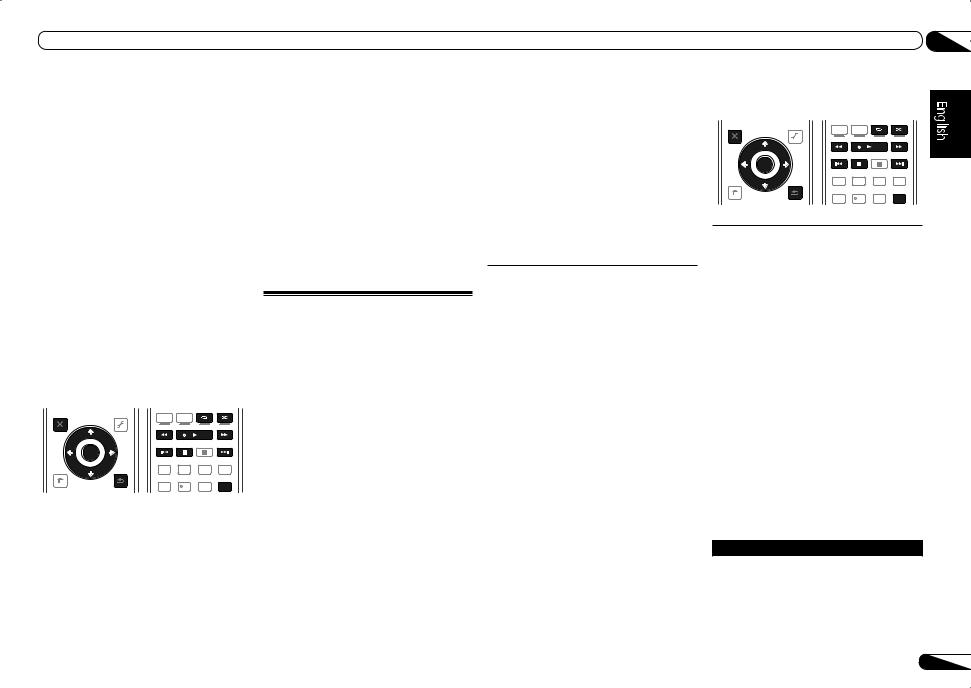
2Use i/j to select a category, then press ENTER to browse that category.
!To return to the previous level any time, press
RETURN.
3Use i/j to browse the selected category (e.g., albums).
!Use k/lto move to previous/next levels.
4Continue browsing until you arrive at what you want to play, then press dto start playback.
 Note
Note
!You can play all of the songs in a particular category by selecting the All item at the top of each category list. For example, you can play all the songs by a particular artist.
Basic playback controls
This receiver’s remote control buttons can be used for basic playback of files stored on an iPod.
!Press iPod USB to switch the remote control to the iPod/USB operation mode.
AUDIO |
|
VIDEO |
|
PGM |
MEMORY |
MENU |
PARAMETER |
|
PARAMETER |
HDD |
DVD |
|
|
LIST |
TUNE |
TOOLS |
|
|
||
|
|
|
|
|||
|
|
|
|
PHASE CTRL |
STATUS |
|
TOP MENU |
|
T.EDIT |
|
|
|
|
BAND |
|
GUIDE |
|
|
|
|
|
|
|
TV/DTV |
MPX |
PQLS |
|
PRESET |
ENTER |
PRESET |
|
|
|
|
|
|
|
S.RETRIEVER |
|
|
AUDIO |
CATEGORY |
|
RETURN |
1 |
2 |
3 |
|
|
|
|
|
|
||
HOME |
TUNE |
|
SIGNAL SEL MCACC |
SLEEP |
INFO |
|
MENU |
|
4 |
5 |
6 |
DISP |
|
iPod CTRL |
|
|
||||
|
|
|
|
|
|
|
!During Audiobook playback, press i/jto switch the playback speed: Faster fNormal fSlower.
Switching the iPod controls
You can switch over the iPod controls between the iPod and the receiver.
!You cannot use this function, when an iPod of fifth generation or iPod nano of first generation is connected.
1Press iPod CTRL to switch the iPod controls.
This enables operation and display on your iPod, and this receiver’s remote control and GUI screen become inactive.
2Press iPod CTRL again to switch back to the receiver controls.
 Note
Note
!Change the receiver’s input to the iPod in one action by pressing the
iPod iPhone iPad DIRECT CONTROL button on the front panel to enable iPod operations on the iPod.
Playing a USB device
It is possible to play files using the USB interface on the front of this receiver.
!Compatible USB devices include external magnetic hard drives, portable flash memory drives (particularly key drives) and digital audio players (MP3 players) of format FAT16/32.
!Pioneer cannot guarantee compatibility (operation and/or bus power) with all USB mass storage devices and assumes no responsibility for any loss of data that may occur when connected to this receiver.
1Press uRECEIVER to switch on the receiver and your TV.
See Connecting a USB device on page 21 .
!Make sure the receiver is in standby when disconnecting the USB device.
2Press iPod USB on the remote control to switch the receiver to the iPod/USB.
Loading appears in the GUI screen as this receiver starts recognizing the USB device connected. When the display shows the USB Top menu you’re ready to play from the USB device.
 Note
Note
If an Over Current message lights in the display, the power requirements of the USB device are too high for this receiver. Try following the points below:
!Switch the receiver off, then on again.
!Reconnect the USB device with the receiver switched off.
!Use a dedicated AC adapter (supplied with the
device) for USB power.
If this doesn’t remedy the problem, it is likely your USB device is incompatible.
Playing back audio files stored on a USB memory device
The maximum number of levels that you can select in Step 2 (below) is 8. Also, you can display and play back up to 30 000 folders and files within a USB memory device.
!Note that non-Roman characters in the playlist are displayed as #.
1Use i/j to select ‘Music’ from the
USB Top menu.
2Use i/j to select a folder, then press
ENTER to browse that folder.
!To return to the previous level any time, press
RETURN.
3Continue browsing until you arrive at what you want to play, then press d to start playback.
!Copyrighted audio files cannot be played back on this receiver.
!DRM-protected audio files cannot be played back on this receiver.
Basic playback controls
This receiver’s remote control buttons can be used for basic playback of files stored on USB memory devices.
Basic playback |
05 |
! Press iPod USB to switch the remote control to the iPod/USB operation mode.
AUDIO |
|
VIDEO |
|
PGM |
MEMORY |
MENU |
PARAMETER |
|
PARAMETER |
HDD |
DVD |
|
|
LIST |
TUNE |
TOOLS |
|
|
||
|
|
|
|
|||
|
|
|
|
PHASE CTRL |
STATUS |
|
TOP MENU |
|
T.EDIT |
|
|
|
|
BAND |
|
GUIDE |
|
|
|
|
|
|
|
TV/DTV |
MPX |
PQLS |
|
PRESET |
ENTER |
PRESET |
|
|
|
|
|
|
|
S.RETRIEVER |
|
|
AUDIO |
CATEGORY |
|
RETURN |
1 |
2 |
3 |
|
|
|
|
|
|
||
HOME |
TUNE |
|
SIGNAL SEL MCACC |
SLEEP |
INFO |
|
MENU |
|
4 |
5 |
6 |
DISP |
|
iPod CTRL |
|
|
||||
|
|
|
|
|
|
|
Playing back photo files stored on a USB memory device
! Photo files cannot be played in the sub zone.
1Use i/j to select ‘Photos’ from the
USB Top menu.
2Use i/j to select a folder, then press
ENTER to browse that folder.
!To return to the previous level any time, press
RETURN.
3Continue browsing until you arrive at what you want to play, then press dto start playback.
The selected content is displayed in full screen and a slideshow starts.
After a slideshow launches, pressing ENTER toggles between play and pause (only when
Theme on the Slideshow Setup is set to Normal (OFF)).
!If the slideshow is left in the pause mode for five minutes, the list screen reappears.
Basic playback controls
Button(s) |
What it does |
|
ENTER, d |
Starts displaying a photo and play- |
|
ing a slideshow. |
|
|
|
|
|
RETURN, k |
Stops the player and returns to the |
|
previous menu. |
|
|
o |
Displays the previous photo content. |
|
<a> |
|
|
|
|
|
|
En |
29 |

05 |
Basic playback |
|
|
Button(s) |
What it does |
p |
Displays the next photo content. |
|
<a> |
||
|
||
e |
Pauses/unpauses the slideshow. |
|
<a> |
||
|
||
DISP |
Displays the photo information. |
|
<a> |
||
|
aYou can only use this button when Theme on the
Slideshow Setup is set to Normal (OFF).
Slideshow Setup
Make the various settings for playing slideshows of photo files here.
1Use i/j to select ‘Slideshow Setup’ from the USB Top menu.
2Select the setting you want.
!Theme – Add various effects to the slideshow.
!Interval – Set the interval for switching the photos. This may not be available depending on the Theme setting.
!BGM – Play music files stored on the USB device while displaying photos.
!Music Select – Select the folder containing the music files to be played when BGM is set to ON.
3When you’re finished, press RETURN.
You will return to the USB Top menu.
About playable file formats
The USB function of this receiver supports the following file formats. Note that some file formats are not available for playback although they are listed as playable file formats.
Music files
Category |
Extension |
|
Stream |
|
|
|
|
|
Sampling frequency |
8 kHz to 48 kHz |
|
MP3 |
|
MPEG-1, 2, 2.5 Audio |
Quantization bitrate |
16 bit |
|
.mp3 |
Channel |
2 ch |
|||
<a> |
Layer-3 |
||||
|
Bitrate |
8 kbps to 320 kbps |
|||
|
|
|
|||
|
|
|
VBR/CBR |
Supported/Supported |
|
|
|
|
Sampling frequency |
32 kHz, 44.1 kHz, 48 kHz |
|
WAV |
.wav |
LPCM |
Quantization bitrate |
8 bit, 16 bit |
|
|
|
|
Channel |
2 ch, Monaural |
|
|
|
|
Sampling frequency |
8 kHz to 48 kHz |
|
|
|
WMA8/9 |
Quantization bitrate |
16 bit |
|
WMA |
.wma |
Channel |
2 ch |
||
<b> |
|||||
|
|
Bitrate |
8 kbps to 320 kbps |
||
|
|
|
|||
|
|
|
VBR/CBR |
Supported/Supported |
a“MPEG Layer-3 audio decoding technology licensed from Fraunhofer IIS and Thomson multimedia.”
bFiles encoded using Windows Media Codec 9 may be playable but some parts of the specification are not supported; specifically, Pro, Lossless, Voice.
Photo files
Category |
Extension |
|
|
|
|
.jpg |
|
Meeting the following conditions: |
|
|
.jpeg |
Format |
! Baseline JPEG format (including files recorded in Exif/DCF |
|
JPEG |
.jpe |
format) |
||
|
||||
|
.jif |
|
! Y:Cb:Cr - 4:4:4, 4:2:2 or 4:2:0 |
|
|
.jfif |
Resolution |
30 to 8184 pixels vertical, 40 to 8184 pixels horizontal |
30 En
